| |||||||
| Search Forums |
| Advanced Search |
| Go to Page... |
 |
| Search this Thread |  482,905 views |
| | #1 |
| Senior - BHPian | Maruti WagonR : Official Review The Maruti WagonR is on sale in India at a price of between Rs. 4.20 - 5.70 lakhs (ex-Delhi). What you'll like: • Unbeatable practicality, with a value-for-money price tag • Spacious interiors. Ingress & egress are effortless too • 340-liter boot has almost doubled in size (compared to the old WagonR) • Awesome 4-cylinder 1.2L engine costs just Rs. 20,000 more than the 1.0L • Suspension offers a more compliant ride than the outgoing car • Features such as the touchscreen head-unit, underseat drawer & well-priced 2nd airbag • Maruti's fuss-free ownership experience & excellent after-sales service What you won't: • Interior quality is budget grade. The Santro is in another class altogether! • Thin & tinny sheet metal. Car feels lightweight when driving as well • Lousy NVH package. Insulation is quite poor • AMT – although improved – cannot match the Santro AMT’s smoothness • Road manners make it suited to the city than the highway. Keep your speeds in check • Some misses like no alloy wheels, missing rear speakers & useless rear headrests • Superior Ignis isn’t priced too far away, especially after discounts Last edited by Aditya : 28th May 2019 at 15:35. |
| |  (51)
Thanks (51)
Thanks
|
| The following 51 BHPians Thank blackwasp for this useful post: | 2himanshu, Added_flavor, Aditya, AdityaDeane, AheadAJ, amit_purohit20, BoneCollector, chiefpk, CrAzY dRiVeR, dailydriver, Dani7766, Déesse, digitalnirvana, Freon911, ganeshb, GTO, hmansari, Iksvaku, InControl, jailbird_fynix, JLS, keroo1099, lemedico, Leoshashi, libranof1987, mh09ad5578, N33raj, NaXal, noopster, NPV, Omkar, PGNarain, phoenixash, Ponbaarathi, PrasunBannerjee, Roy.S, sandx, Scorpion 10, Siddy, Simat, Simhi, Sip, SnS_12, swiftnfurious, theexperthand, The_Outsider!, vaasu, Varun_HexaGuy, Vik0728, VTec_KickedInYo, ysjoy |
| |
| | #2 |
| Senior - BHPian | Review Index: Exterior Last edited by Aditya : 28th May 2019 at 15:26. |
| |  (14)
Thanks (14)
Thanks
|
| The following 14 BHPians Thank blackwasp for this useful post: | Aditya, CrAzY dRiVeR, dailydriver, Déesse, digitalnirvana, GTO, jailbird_fynix, Leoshashi, libranof1987, NPV, phoenixash, Simat, theexperthand, Varun_HexaGuy |
| | #3 |
| Senior - BHPian | Exterior  It was 1999 when the Maruti WagonR was introduced in India. Since then, it has been one of the most successful products from the Maruti Suzuki stable. The car has always been a hit with no-nonsense car buyers in the country. The car's appeal has always been its practicality and for the third-generation model, the company has simply improved upon it! Maruti claims to have sold 2.2 million WagonRs till December 2018. Over the last 10 years, the car has managed to consistently appear in the list of top 10 selling cars in India. On a monthly basis, Maruti has managed to move more than 13,000 units regularly and in better months, it has even managed to cross the 15,000 unit mark. This car has been a true sales champion. WagonR owners are known for their loyalty towards the brand. While 51% of all customers are first time buyers, 24% are repeat customers! There's a reason for that. The car is as good as it gets in terms of practicality. The tallboy design, easy ingress & egress, space, tall seating, bi-fuel options, low cost of ownership and Maruti's strong service network are key factors in attracting buyers. That said, the 2nd-gen had a l-o-n-g run. Nine years is simply too long and the car felt outdated over the last 2 – 3 years.  Like the old car, the new WagonR competes in the B1 segment, which has a new competitor - the formidable Hyundai Santro. The WagonR sits at the top of the segment with respect to sales numbers followed by its stablemate - the Celerio, which has also been a fairly successful model. The Tata Tiago is the sole car to offer both diesel and petrol options in the segment, and is one of the better-equipped vehicles too. The outgoing car came with a 3-cylinder 1.0L petrol engine. While that engine has been carried over, this time around, Maruti has also offered the superior 4-pot 1.2L engine on the top two variants. For a mere Rs. 20,000 more than the 1.0-liter, it’s a no-brainer to pick up the larger engine. It comes with a choice of a 5-speed MT or an AMT gearbox. Maruti sure has pulled a rabbit out of the hat here! Hyundai didn’t expect the 1.2L option at all. Make no mistake, this is the best engine in the segment. Since the WagonR is such an important car for Maruti, the company has invested Rs. 670 crores in it. It must be noted that this car is completely different from the WagonR sold in Japan. It is based on the Heartect platform, which is shared with the Swift, Baleno, Dzire, Ignis and the new Ertiga. Coming to dimensions, it is 60 mm longer and 125 mm wider than the older car. Its wheelbase of 2,435 mm is 35 mm longer too. However, at 1,675 mm, its height is 25 mm lesser than the old car's. The new car weighs 830 kg (for the 1.2L) and 805 kg (for the 1.0L) compared to the outgoing car's kerb weight of 825 kg. This lightweight nature is evident throughout the time you spend with the car. The WagonR's build is flimsy & thin. Panel gaps were inconsistent across different cars - especially around the bonnet area. The doors are light, but not as light as the Alto's, while the bonnet has weight for a car of this segment. There is some flex on the front fenders and doors when pressed with a thumb (this flex is much lesser on the bonnet, hatch and rear fenders). The paint quality of the car is good and Maruti is offering some interesting colours like Autumn Orange and Poolside Blue. Conservative options like Superior White, Silky Silver and Magma Grey continue to be offered. The Red colour is sadly no longer an option now. Coming to safety, all variants of the WagonR are equipped with a driver airbag, ABS + EBD, rear parking sensors, front seatbelt reminder and high speed alert as standard. Maruti has used high strength steel in this car, which is claimed to improve the safety and rigidity. Well, going by Maruti's track record in safety (rather, the lack of it), we'll only believe the NCAP crash test reports if & when they come in. Maruti has kept the front end of the car neutral and inoffensive. It is significantly better than the outgoing car (told by many passers-by during our testing). Chrome ‘S’ logo and the stripe keep the bling to a minimum. Looks-wise, the car has definitely grown up and is more mature:  Rounded edges make the car look slightly less boxy than the outgoing one. Tall tail lamps meet the bumpers, which stretch up a long way. Exhaust pipe is clearly visible on the right:  The WagonR measures 3,655 mm in length and 1,675 mm in height making it the longest and tallest car in the segment. Its width of 1,620 mm falls short of the Santro and the Tiago. Its 2,435 mm wheelbase is the longest among its peers. Despite being an all-new generation, one will instantly recognize it as a WagonR only. The design is very evolutionary in that sense:  It is apparent where all the extra length has gone into the car. Despite this, the new WagonR is 20 kg lighter (1.0L) and just 5 kg heavier (1.2L) compared to the outgoing car. That said, the build quality is very flimsy and thin:  From this angle, notice the squared wheel arches and the character line that dips towards the rear. The WagonR has sure grown up. Looks like a mini-MPV from some angles: 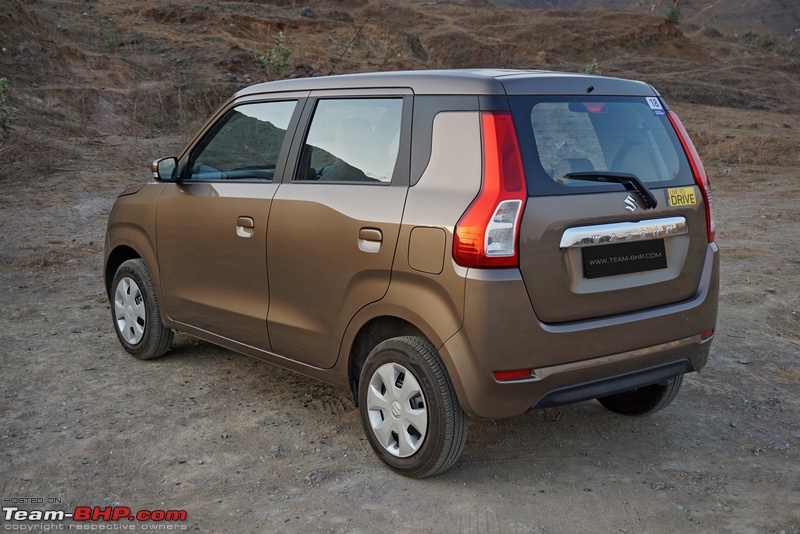 Headlamps are funky looking as well as functional: 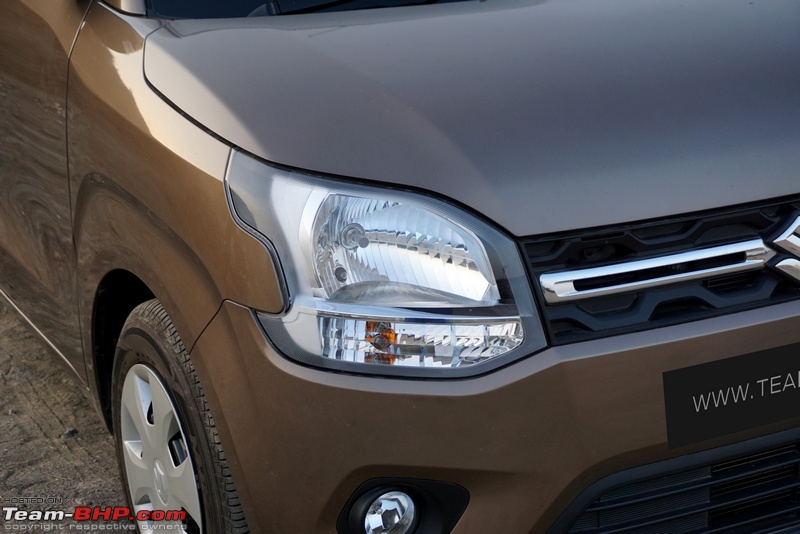 With all the lights in action. There are no follow-me-home or lead me to vehicle functions provided: 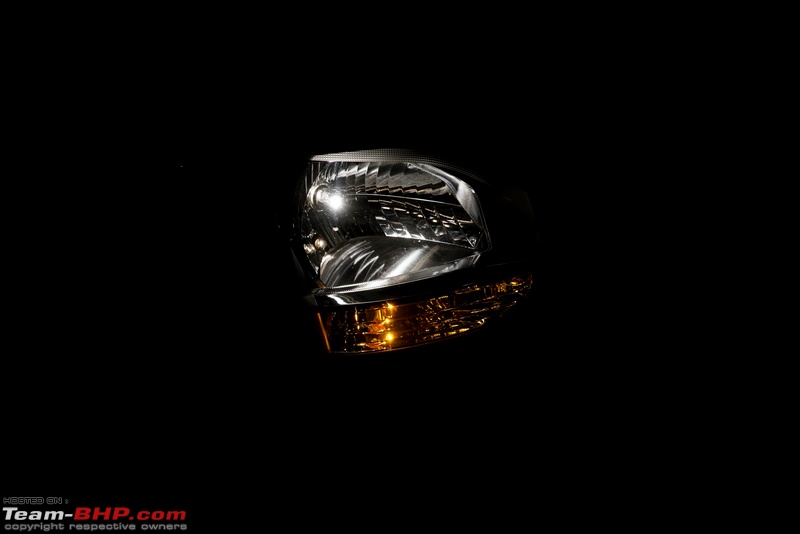 Circular fog lamps are placed in black housings. They offer adequate illumination. Towing point is located on the left:  Rectangular grille gets trapezoidal detailing and a dual chrome stripe. ‘S’ badge sits in the middle. Note that some of the openings are sealed:  Single disk horn is visible in the upper corner:  Air dam is two-thirds open. One can see the condenser through it:  No underbody protection offered! Not even a plastic plate. This is unacceptable in Indian conditions. Maruti should have known better: 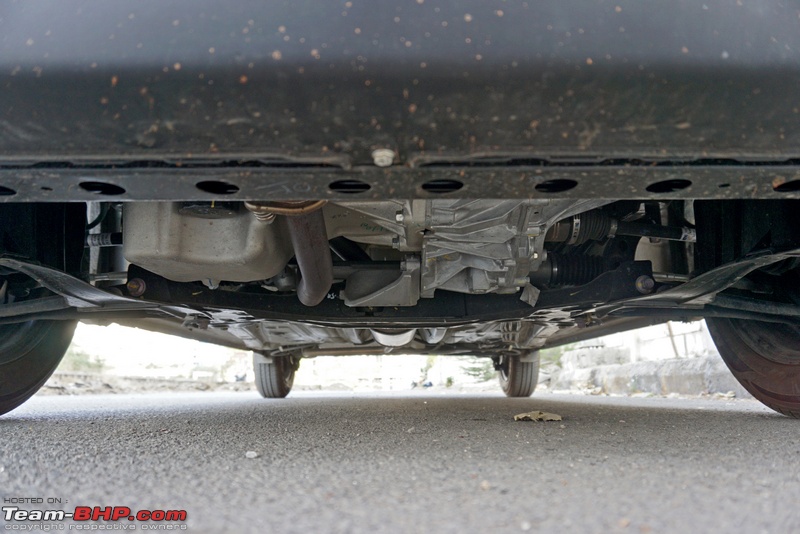 Bonnet has two creases that align with the headlamps:  Wiper spindles are concealed under the bonnet... 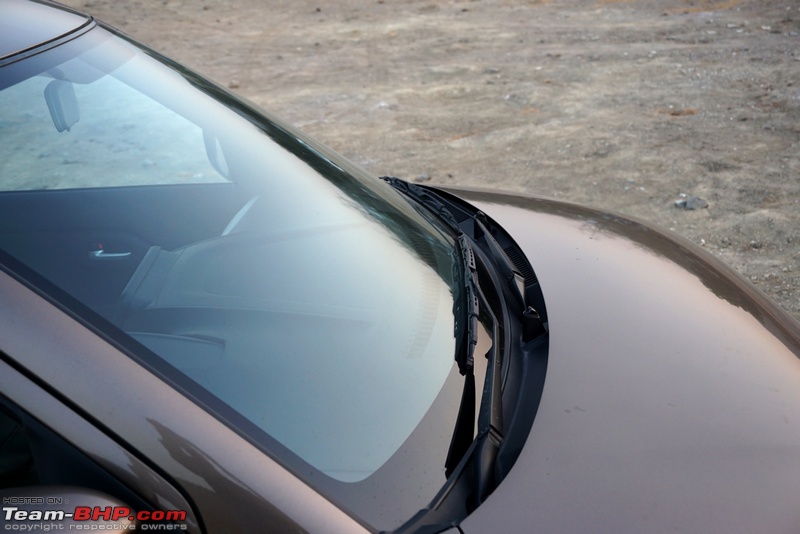 ...as are the windshield washers: 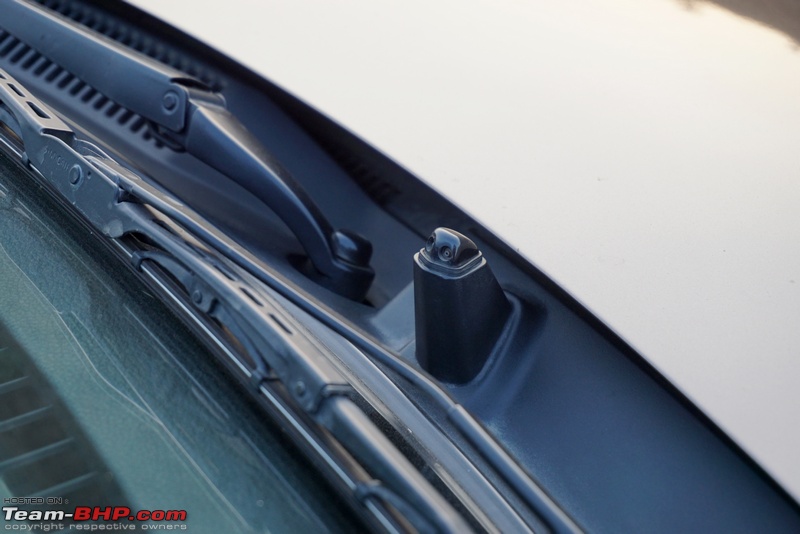 Both windshield washers squirt dual jets of water. The wipers have a good sweep:  Panel gaps have not been a strong point of Marutis. They are wide, especially around the bonnet:  A look at the shut lines of the doors vs the bonnet:  Body coloured ORVMs house integrated turn-indicators. They can be electrically adjusted as well as folded. Compared to the outgoing car, they are smaller in size:  Flap-based body coloured door handles sure feel outdated in 2019! Like the old car, the keyhole is located on the door rather than on the door handle. It is present only on the driver’s side:  Glass area is large. However, the quarter glasses that were present in the old car have been left out. The B-pillar and a part of the C-pillar are blackened. The C-pillar is very thick:  Thick C-pillar gets a black panel to create a 'floating roof' effect:  Wheel arches are prominent with a square design. They extend onto the front doors:  Character line runs down below. Look closely - it appears to meet both the wheel arches:  Rear wheel arches are prominent as well, with a very strong character line above extending into the rear door and bumper:  14" steel rims shod with 165/70 section MRF ZVTV tyres. We feel this tyre size is too small for the car. Should get at least 185 mm in the interest of safety. Alloy wheels are not offered on any variant. Lower variants get 155/80 section tyres on 13" rims:  Front tyres get aero flaps in front of them…  …as do the rear ones:  Ribbed roof adds rigidity and minimizes material weight. Roof rails are no longer provided. The outgoing car had them:  Long, old-fashioned radio antenna sits at the front of the roof:  Rear washer nozzle juts out of the top of the tailgate unpleasantly. Should have been better integrated:  L-shaped rear wiper is mounted on the tailgate at an off-center position, just like the outgoing car:  The nozzle spray action is sad. On the other hand, the wiper is very effective. It covers a large area of the rear windshield:  Volvo-inspired halogen tail-lamps look a size too big for the car:  With all the lights in action:  Hatch is wider at the bottom than the top. The HMSL is moved inside, behind the windshield. There's no engine, transmission or variant badging on the tailgate or anywhere else on the car - only the Suzuki and WagonR branding on the chrome garnish. BHPians will love the partial debadged look: 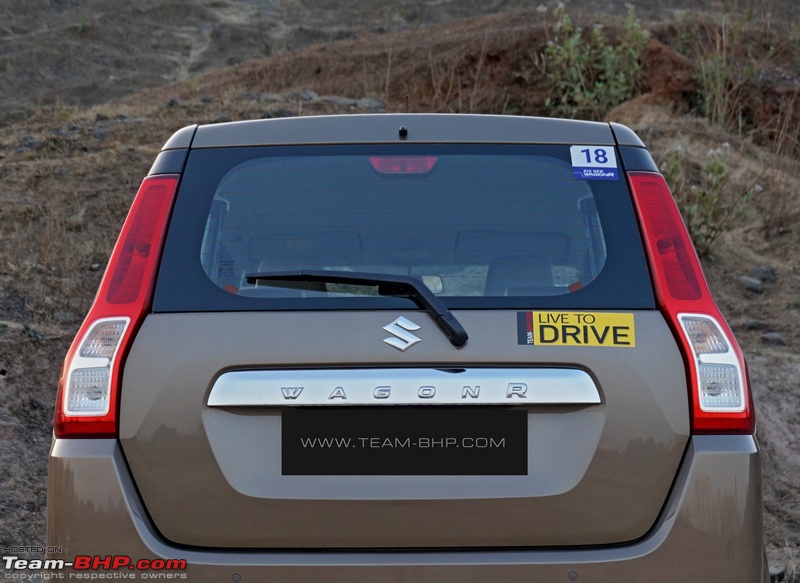 Chrome garnish gets embossed WagonR lettering. There is no keyhole for unlocking and opening the hatch like the old car. No reversing camera provided on any variant:  Hatch can be opened using this release lever. It is slightly harder to operate than you expect and one needs to apply a little more force:  Bumper gets a crease with a reflector on both sides and a small black insert at the bottom. Two reverse parking sensors are provided as well:  Both parking sensors are placed towards the middle area of the bumper:  Rear bumper gets 2 slim reflectors. The outgoing car came with a single rear fog lamp located in the center of the bumper:  Rear suspension uses a torsion beam setup. Towing hook is located beside the exhaust on the right side:  The new WagonR, while still boxy, has a much rounded appearance than the old car. We feel this car will age a lot better over the years than the outgoing model:  You can make out the excess length of the new car by looking at the thicker C-pillars as well as the wheelbase:  The WagonR looks one size bigger than its traditional tallboy rival - the Santro:  Beside its stable mate from the same segment. While the Celerio is a more conventional hatchback in design, the WagonR is more practical: 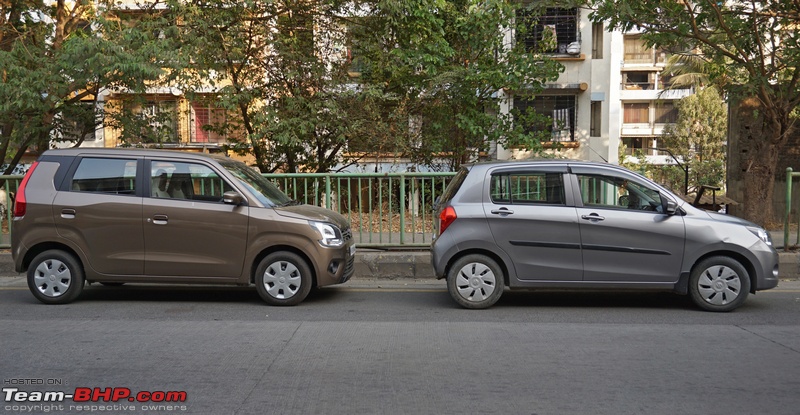 Last edited by Aditya : 2nd June 2019 at 17:30. |
| |  (33)
Thanks (33)
Thanks
|
| The following 33 BHPians Thank blackwasp for this useful post: | Aditya, AdityaDeane, AkMar, chiefpk, Col Mehta, digitalnirvana, ganeshb, GTO, Iksvaku, InControl, jailbird_fynix, lemedico, Leoshashi, libranof1987, N33raj, noopster, NPV, PGNarain, phoenixash, Ponbaarathi, PowerSpike, RaghuVis, raptor_diwan, Scorpion 10, shancz, Simat, SnS_12, sparky@home, theexperthand, The_Outsider!, TusharK, vaasu, Varun_HexaGuy |
| | #4 |
| Senior - BHPian | Interior - Front  The front doors of the WagonR open and shut in a three-stage action. While the overall sheet metal of the car feels light, the doors are relatively heavier. Make no mistake, there is no European car like "thud" when you shut them, but they feel sturdier than the outgoing car's. They open super wide and the running board isn't too broad. The floor is low and the roof high, making ingress and egress effortless. This is a WagonR trademark. Once inside, there is a healthy amount of legroom at the front. The cabin is also wider than the outgoing car's and there is a marked increase in the shoulder room. The headroom is amazing - another WagonR trademark. The greenhouse is large and there is ample light entering the cabin to keep occupants from feeling claustrophobic. The use of beige on the dashboard, seats, B & C-pillars and the light grey roofliner helps matters. The dashboard is functional and looks better in person than the pictures. It has a beige & black theme and the AC vents get brushed silver inserts. The doorpads and floor are thankfully all black, as lighter colours tend to get spoilt very easily in our conditions. As one would expect, the WagonR gets hard plastics on the dash. The quality is budget grade, but you will be hard pressed to find rough edges and ill-fitted bits. All controls are well laid out and the cabin is overall ergonomic. Everyone who drove the car felt at ease within 5 minutes of getting into it. The switchgear is picked up from other Maruti cars and the stalks especially feel good to operate. That said, the overall quality of buttons is average. You just cannot compare the WagonR it to its main rival - the Santro when it comes to part quality. Black and beige dashboard with silver highlights and a touchscreen head unit in the middle is functional. Ergonomics are spot on and overall cabin is practical and user-friendly:  Tall driving position and good view of the road ahead. Dashboard isn’t placed too high:  Lateral and overall visibility is good. Glass area is big. Front windows are huge and A-pillars are not too thick. They don't cause any blind spots:  Dashboard is fairly deep - the length from the windshield is long. Large flat surface in the middle is perfect for your favourite dashboard figurine:  3-spoke steering wheel is taken from the Ignis, but has one button less. While it does not get a leather cladding, it features silver inserts and a chrome "S" logo in the middle. The wheel size and thickness are spot on. It feels great to grip and operate. Hornpad is large and easy to press, but those with smaller fingers will find it a stretch to reach it:  Buttons to controls the infotainment system are on the left side, while the right is blank. The buttons are easy to operate and provide decent feedback. A mute button has also been provided:  Call answer / disconnect and voice command buttons are placed down below. You have to press these buttons instead of pulling them towards you:  Steering gets tilt adjustment. The adjuster is located at a convenient place and is easy to operate: 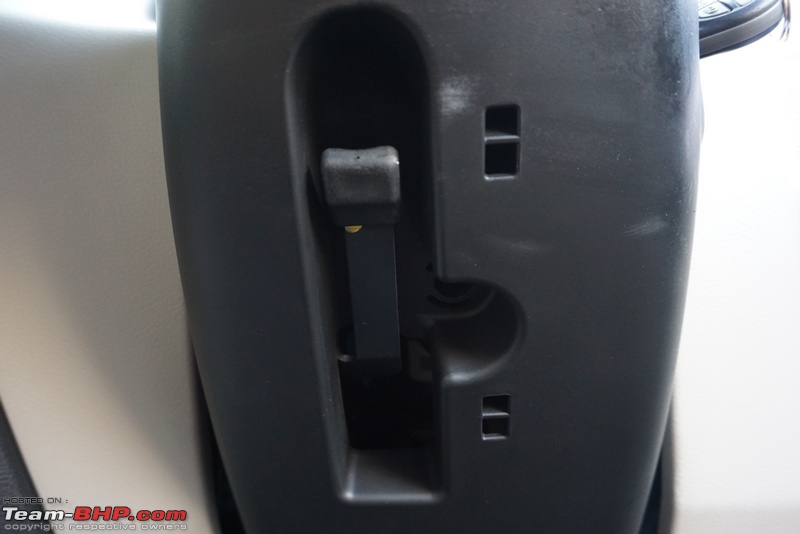 Instrument cluster is easy to read and dominated by a large speedo in the center. A circular dial on the right houses the digital rev counter, fuel gauge, clock and the single line MID. No temperature gauge provided. The numerals of the speedometer are backlit in white, while the MID cluster gets orange lighting. Notice the broken orange ring inside and the dual orange rings around the numbers:  Old & ugly stalk for toggling through the various functions of the MID:  The digital tachometer shows rpm in multiples of 250, and the MID gets 2 trip meters:  MID also displays average and instantaneous fuel efficiency and distance to empty:  The low fuel warning is shown inside the speedometer, while the general "door ajar warning lamp" comes on whenever any door is opened, but not for the hatch or the bonnet:  Stalks are chunky and nice to use, but don't feel as nice as the Santro's. Front and rear wiper controls are on the left, while light controls are on the right stalk. Foglamp switch is integrated in the light stalk:  Ribbed detailing on the foglamp switch for a better grip:  Standard keyhole with no illumination, just like other cars in the segment:  Circular side air-con vents get a silver ring around them. Cup holders in front of air-con vents (for cooling) are gone: 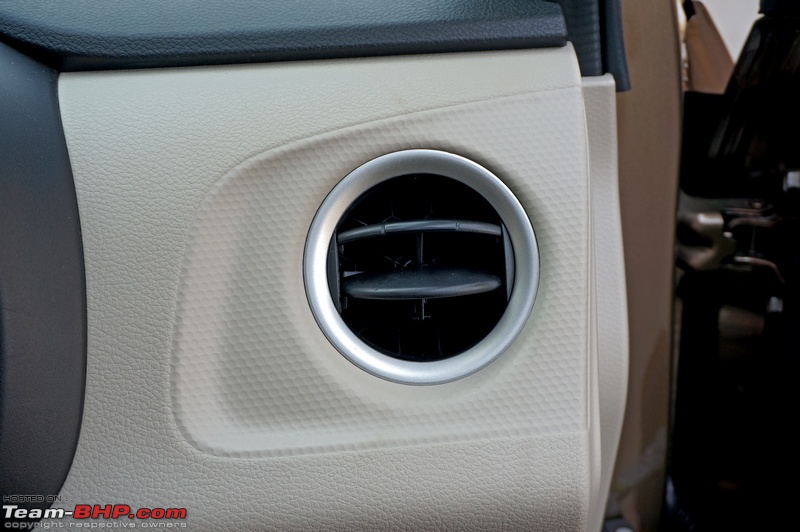 Side air-con vents can be shut, though they still let out a small amount of air:  Headlamp leveller is located below the right air-con vent. It is backlit in orange. The CNG variant gets the CNG / Petrol mode switch beside the leveller:  Bonnet release lever looks like an afterthought. There is also some play in it and you need to apply more force than you'd expect to operate it: 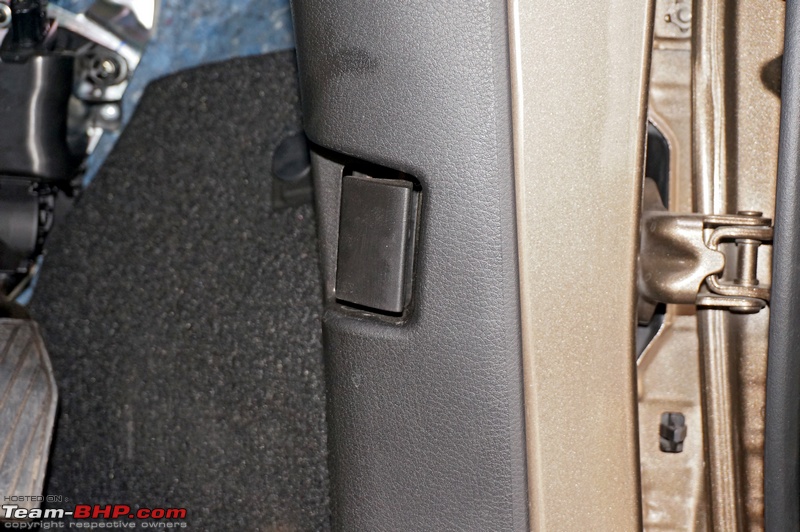 Fuel flap release lever is placed conventionally on the floor. Notice how the floor mat is cut around it and there is a depression below the lever so that there is space to slide for your fingers under it: 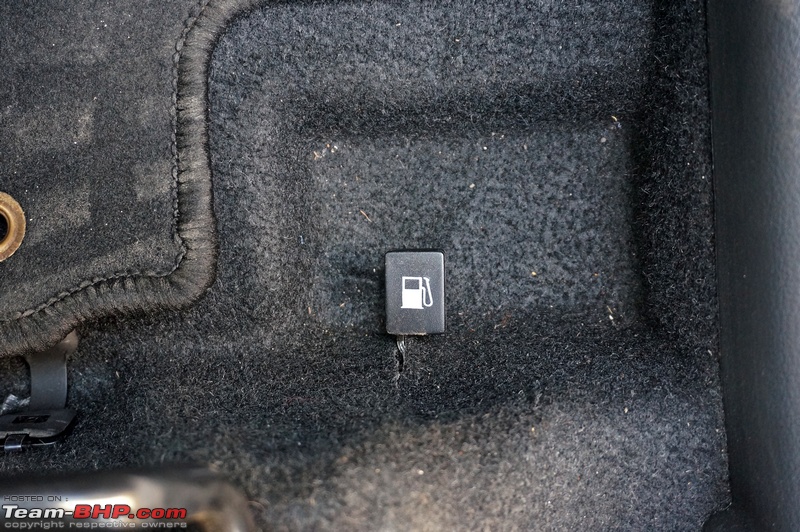 Doorpads are black, not beige. A good thing for practicality. They are fitted much better than the outgoing car's yet you still see some movement in them while operating the windows. The contours and creases on the doorpads make them look nice, but it sucks that doorpads no longer get fabric inserts like the outgoing car:  Standard Maruti console that we've been seeing since ages. The Maruti team obviously has some kind of emotional attachment to this piece. It's an eyesore and doesn’t feel nice to use either – very utilitarian in design & feel. Only driver's window gets one-touch down functionality and button illumination. Door mirrors are electrically foldable:  Door handles are finished in silver. Black exposed screw looks ugly. Thankfully, it is masked to some extent by the black housing:  Armrest is narrow, but good enough to rest your elbow on long drives:  Good door pockets. They are well sized and get a 1L bottle holder each and space to store other knick-knacks:  Door sills are not wide and hence less effort is needed to move your legs in and out of the car. No scuff plates provided, but notice the WagonR branded floor mats:  Front seats are upholstered in fabric and get an asymmetrical design. They are flat and very budget grade. The seats could have been a tad firmer so that they would be more suitable for long distance drives. Under-thigh and lower back support offered is sufficient:  Integrated headrests are well positioned and suitable for all. However, the outgoing car offered adjustable ones. In the new car, Maruti has taken a step backwards:  Sturdy lever to recline the seat feels durable. No height adjustment for the driver's seat in any variant:  Front seats get a metal bar for fore & aft adjustment: 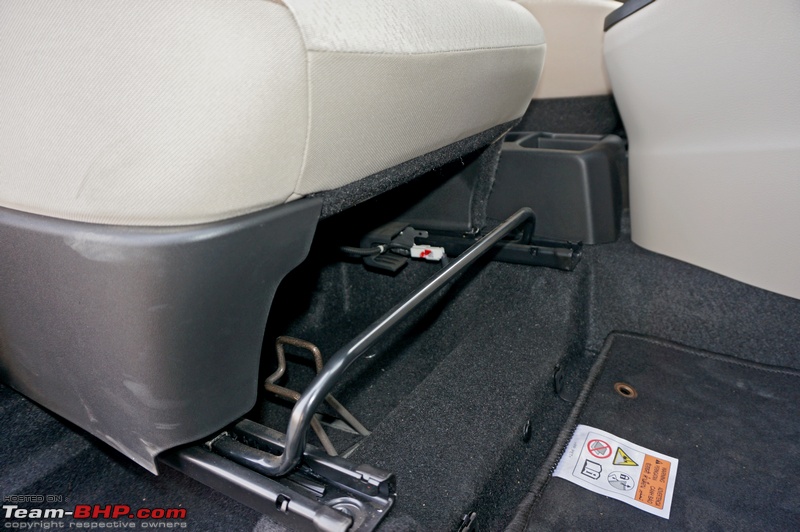 Fore & aft seat travel is more than enough to accommodate tall and short drivers alike:  A close look at the fabric upholstery:  Seatbelts are not height-adjustable. However, they are placed at a comfortable height and will suit most occupants. They get pre-tensions and force-limiters: 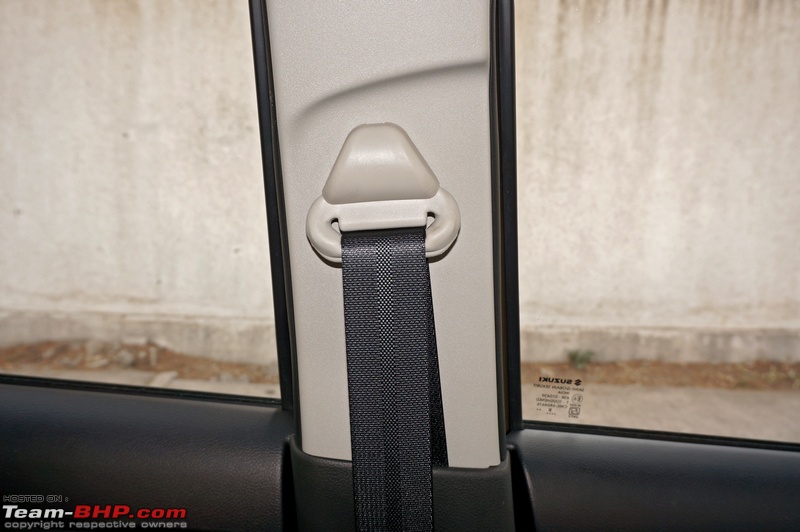 The standard Maruti A, B, C pedals are well spaced out. Dead pedal has been provided. While it could have been wider, it is useable: 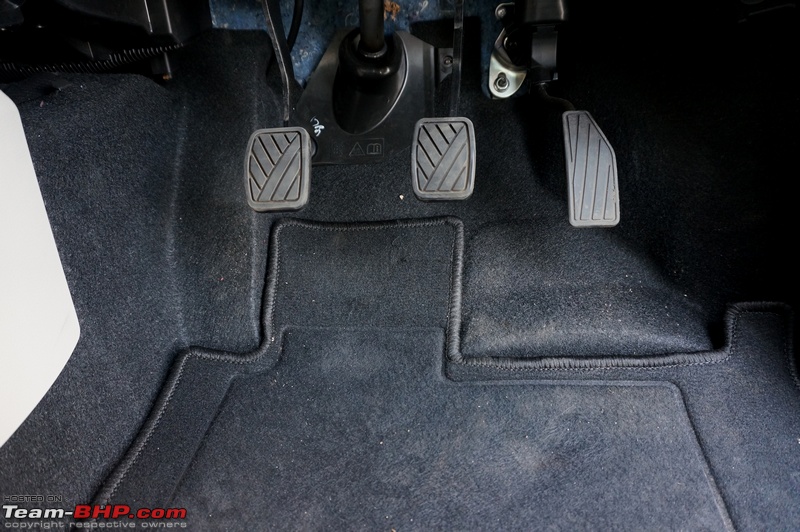 ORVMs are lifted from the Celerio. They can be electrically adjusted and retracted. While they offer sufficient view of things behind, they are much smaller than those of the outgoing car. The old car had huge ORMVs:  IRVM is on the smaller side and barely covers the large rear windshield:  Manual day / night adjustment is provided on all variants except the base model:  Rear windscreen is large compared to other hatchbacks, which is good. However, the thick C-pillars limit rearward visibility while parking:  Center fascia is minimal in design, but functional. The gear lever is mounted on it more towards the driver's side. The air-con vents get silver surrounds:  7.0-inch touchscreen infotainment system sticks out at the top (its functions are covered in detail in a separate post). It is flanked by trapezoidal air-con vents. The one on the right falls just behind the left hand of the driver when placed on the steering wheel. Due to this the cold air from the vent freezes the driver's left hand. Large hazard light switch is located below: 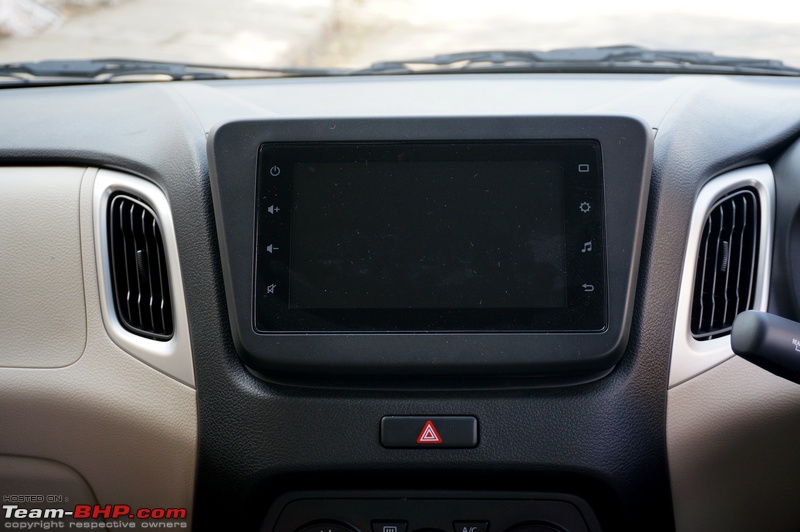 Climate control is not available on any variant. Instead, you get a manual HVAC unit. Air-con controls are basic and the defogger and compressor buttons are tiny. They can be operated without taking your eyes off the road only after getting used to. The manual slider for the fresh air and recirculation modes looks outdated. The air-con doesn't feel as effective as the outgoing car. Reason = larger cabin. On a hot day, it takes a while to cool down the cabin even with the blower on level 4. The blower is silent on level 1 and audible on level 2. It gets loud on level 3 and very loud at level 4:  12V socket is provided on all the variants, while USB and Aux-in ports are offered on the VXi and ZXi trims. The 12V socket gets a rubber cover, while the USB and Aux ports gets a plastic cover: 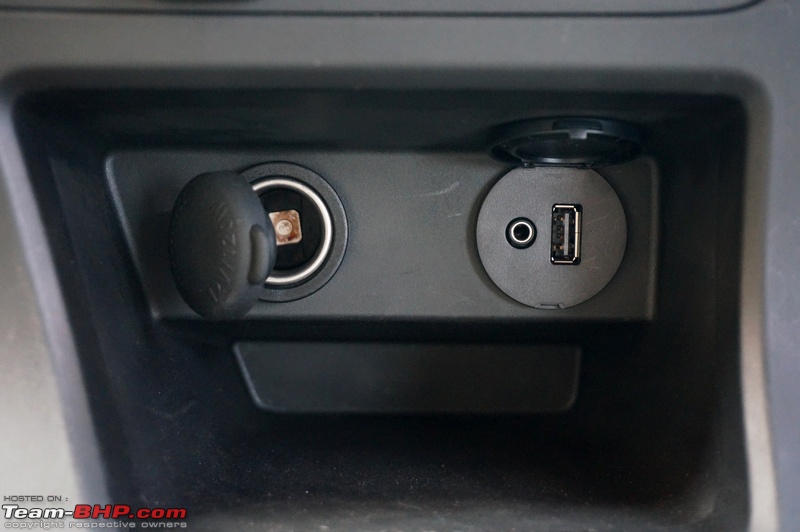 Storage space in front of the gear lever can be used to park your smartphone. Here's a 4" phone for reference. A 6" phone will stick out: 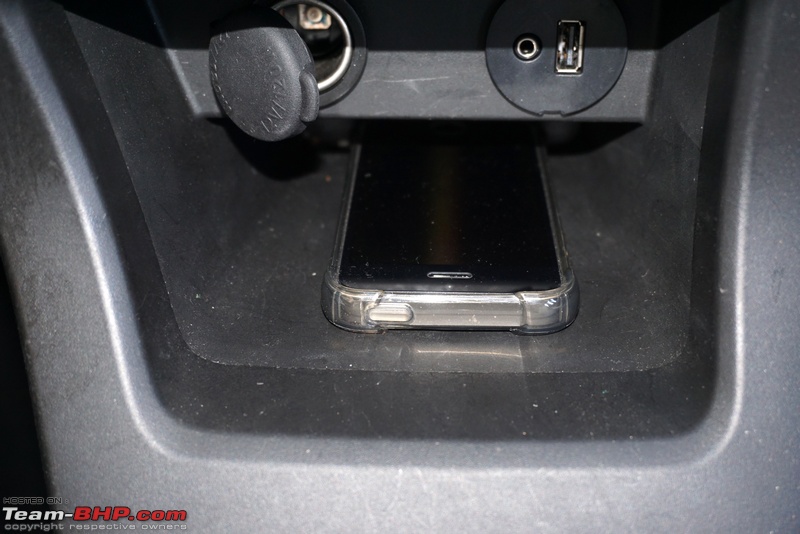 Bird's eye view of the handbrake console & its storage areas:  Single cupholder at the front of the console can accommodate a 1L bottle:  A raised compartment has been provided on the left for keeping small items (e.g. coins). Both spaces get a dotted texture on their plastic base: 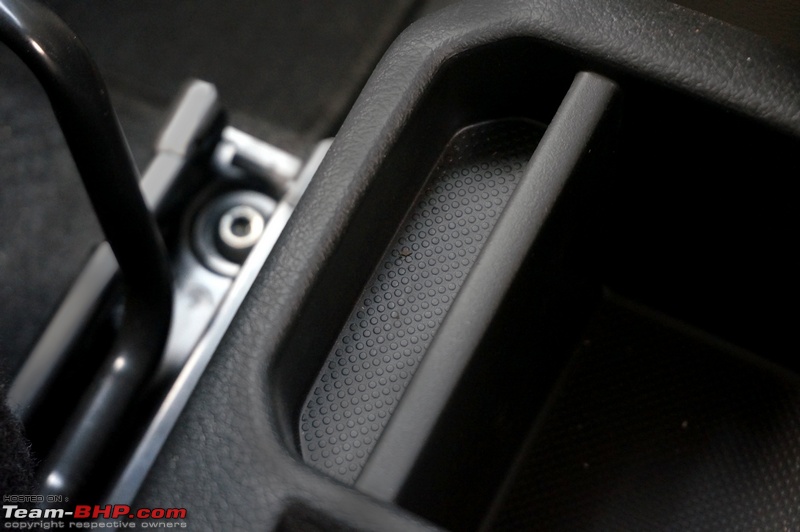 Passenger side of the dash gets an overdose of beige. Black or silver inserts would have kept things from getting boring:  Glove box is medium sized...  ...but fairly deep:  Large flat surface on top of the dashboard to place a deity of your choice:  Single cabin lamp is placed in the front. If there's only one cabin lamp, it's best placed in the roof's center and not here at the front. Bluetooth mic positioned in line with the IRVM and cabin lamp:  Sunvisors are economy grade in design and feel. Driver-side unit gets a flap to hold tickets:  Passenger-side sunvisor has a vanity mirror, but no cover or light:  ZXi variant gets dual front airbags. All other variants have a driver's airbag as standard with a passenger airbag available as an option for a mere Rs. 5,000-7,000 more:  Things are neat and tidy even in places where most people won’t look. There are no loose wires or cables dangling anywhere. Here is a look under the dashboard in the driver's footwell...  ...and in the passenger's: 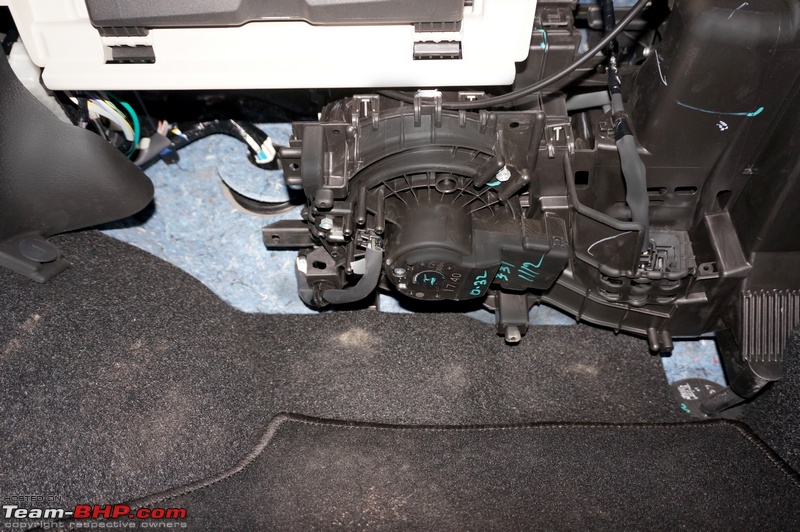 Jack is now placed under the driver’s seat. Weirdly, the rest of the tool kit is in the boot:  Last edited by GTO : 29th May 2019 at 08:10. |
| |  (29)
Thanks (29)
Thanks
|
| The following 29 BHPians Thank blackwasp for this useful post: | Aditya, AdityaDeane, AheadAJ, AkMar, chiranjitp, dailydriver, digitalnirvana, GTO, InControl, jailbird_fynix, lemedico, Leoshashi, libranof1987, N33raj, NPV, phoenixash, Ponbaarathi, PraNeel, RaghuVis, raptor_diwan, Scorpion 10, Simat, SnS_12, swiftnfurious, theexperthand, TusharK, vaasu, Varun_HexaGuy, vishys |
| | #5 |
| Senior - BHPian | Interior - Rear The rear doors open in a two-stage action. They open wide and with the tall roof and low floor, ingress is very easy. My granny found the car much easier to get into than many other cars. The seat is placed at a comfortable height as well, which means you don’t have to sit down in it. The elderly will love the WagonR: 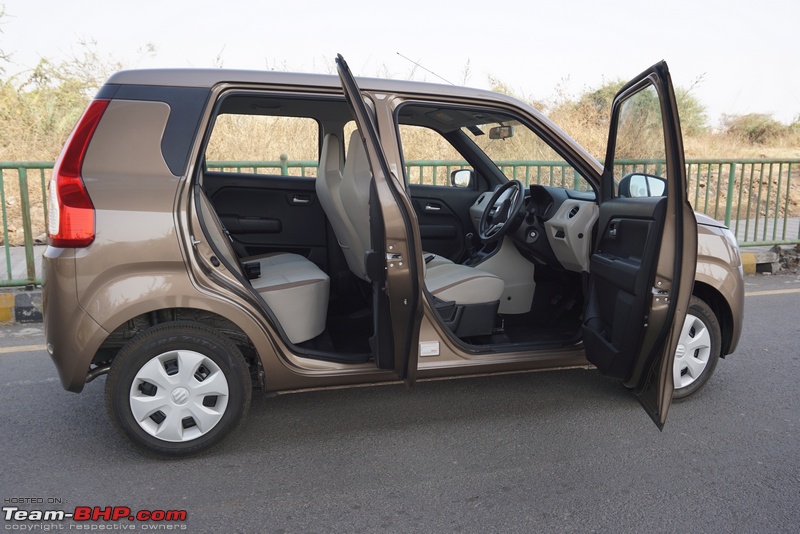 The gap between the seat and the B-pillar is sufficiently wide to make it easier to step in & out: 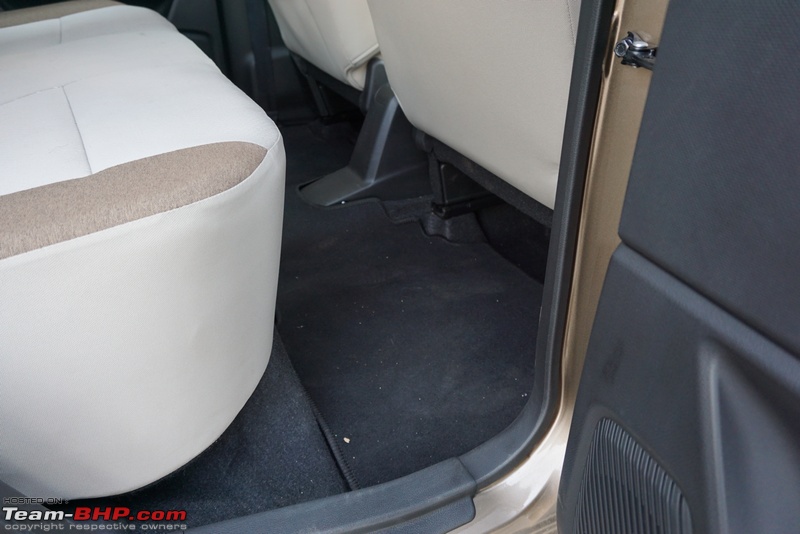 Door sill is not wide either, which means passengers do not have to swing their feet much:  Like the front doorpads, the rear too gets an all-black theme. Armrest is of a decent size and usable for most occupants:  Rear doors get individual power window switches. Door grab handle can double up as a small storage space: 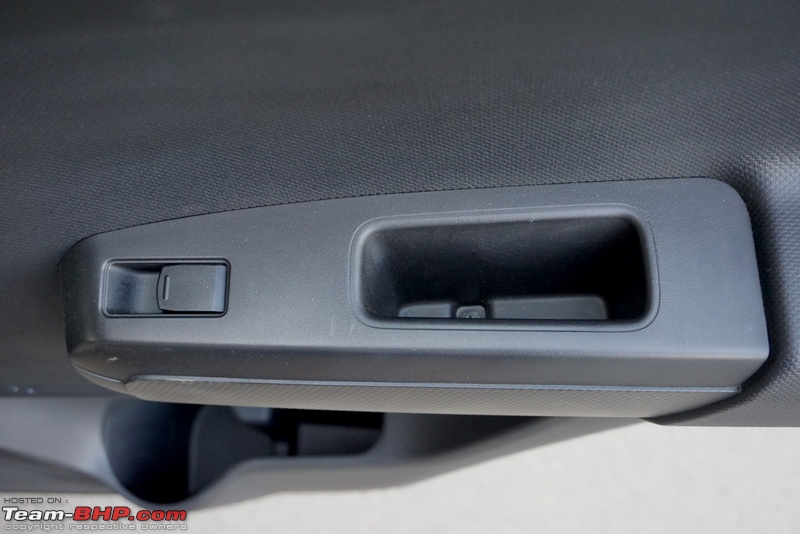 The rear doorpads finally get door pockets. They can accommodate a 1L bottle and have some space for other knick-knacks as well:  Rear seat is wider than the outgoing car and can seat 3 better. The seat base and the backrest are almost flat with minimal contours in the middle:  Both side occupants get fixed headrests, which are useless especially for taller folks. This is a disappointment since the old car had adjustable units. Nothing for the middle occupant:  Believe it or not, the new WagonR gets even more legroom than the outgoing car. It is very spacious and two 6-footers can comfortably sit one behind the other:  A look at the maximum and minimum legroom available:  Seats are not scooped out, but they are soft. So even if your knees touch them, they will not feel uncomfortable. The seatbacks should have been of a darker shade as beige gets soiled easily and is harder to maintain:  With the front seat in my driving position (I'm 6'), I have ~5 inches of knee room. With the front seats pushed all the way back, my knees just touch the seatback. Further, the front seats are mounted on raised rails, allowing you to tuck your feet below them easily:  Front seatbacks are upholstered in carpet material at the bottom where the legs of the rear passengers might touch them. Well thought out:  The rear seat is set at a comfortable height and offers adequate under thigh support. Backrest angle is comfortable and the headroom is excellent. Aditya, who is 5'10" had more than enough clearance. The biggest grouse here are the headrests. They are just useless for taller occupants - they neither offer support nor protection from whiplash injuries:  Rear window is massive and allows a huge amount of light into the cabin. While the old car had fixed quarter glasses, the new one doesn't. One can now roll the whole window down:  The rear window does not roll down all the way. About 2" of glass remains visible:  Seatback pocket is provided only behind the front passenger seat, just like the outgoing car. It is fairly deep and can hold a 14" laptop:  Fixed grab handles above all passenger doors. Maruti has saved some money here - the older car came with spring-loaded handles:  Seatbelts are mounted on the higher side. Shorter occupants could find them running across their throats:  Slot to park seatbelt when rear seat is being folded:  Light grey roofliner makes the car feel airy. Single cabin lamp is placed right in the front - when a single lamp is given, it should be placed in the middle so that it can serve both rows:  No bottle holder in the center like the outgoing car had. No air-con vent either. The Santro comes with one and we feel the WagonR should have had it as well. This is mainly due to the position of front center air-con vents. While the air-con itself is sufficient, thanks to the narrow vents and large glass area, it takes a while to cool the interiors of the car, especially if parked under the sun:  Floor hump is ~2 inches high and wide. Center passenger will have to place his feet on either side of it: 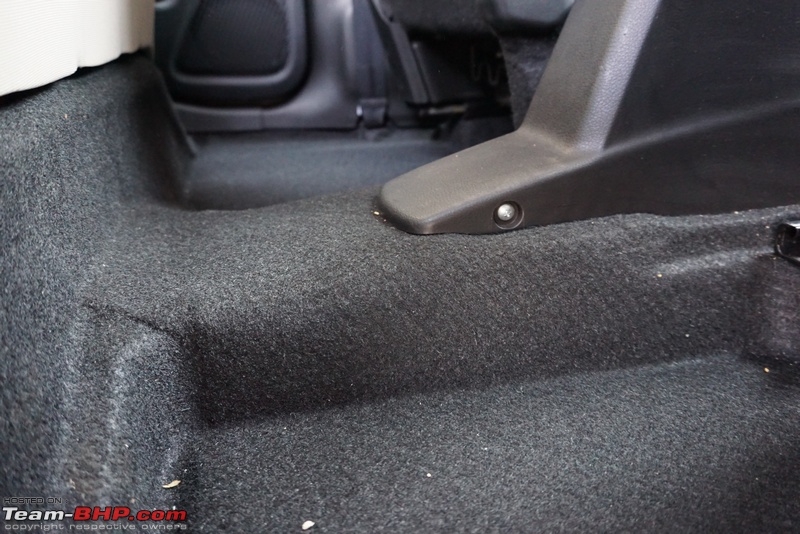 340-liter boot is much bigger than the old car's (180 liters). The Santro and Celerio get 235-liter boots while the Tiago comes with a cargo capacity of 242 liters. It's commendable how Maruti has managed to make so much space inside the car:  Usable space is good enough to accommodate small to medium-size bags. No boot lamp provided:  Here's a large backpack for scale. Even check-in bags can be accommodated provided the parcel tray is removed: 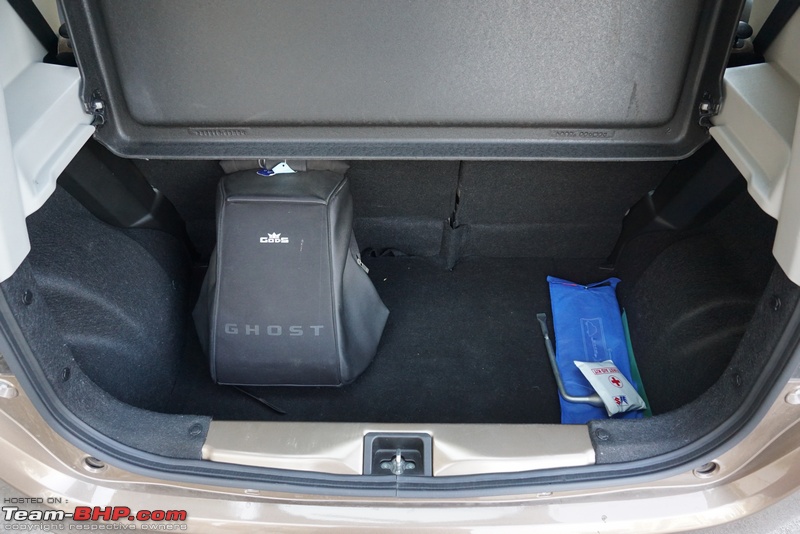 Large parcel tray gets raised borders and 2 rubber bump stops to prevent rattles. No strings provided to hook it on to the hatch:  Minimal gap between the tray and rear seats. On aspects like these, Maruti has improved:  For increasing cargo space, the rear seats can be folded down. Pull this knob up to unlock the seatback. There's one on the other side too. They appear flimsy and may not last as long as the car if you fold the rear seats frequently: 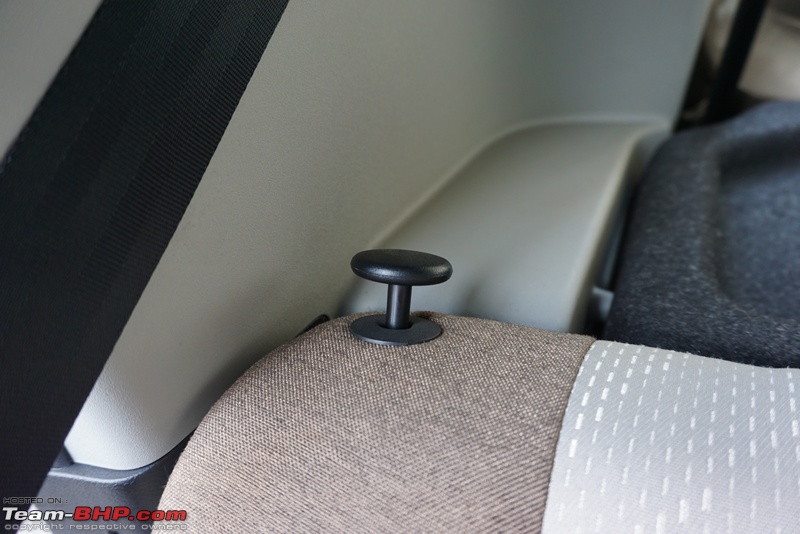 Rear seats can be folded in a 60:40 ratio. Except for base LXi, all other variants get this feature: 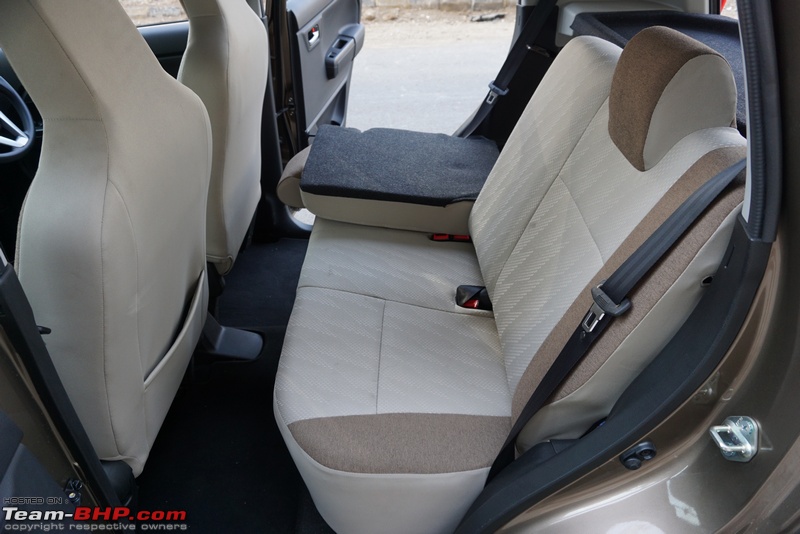 Rear seat folds almost flat: 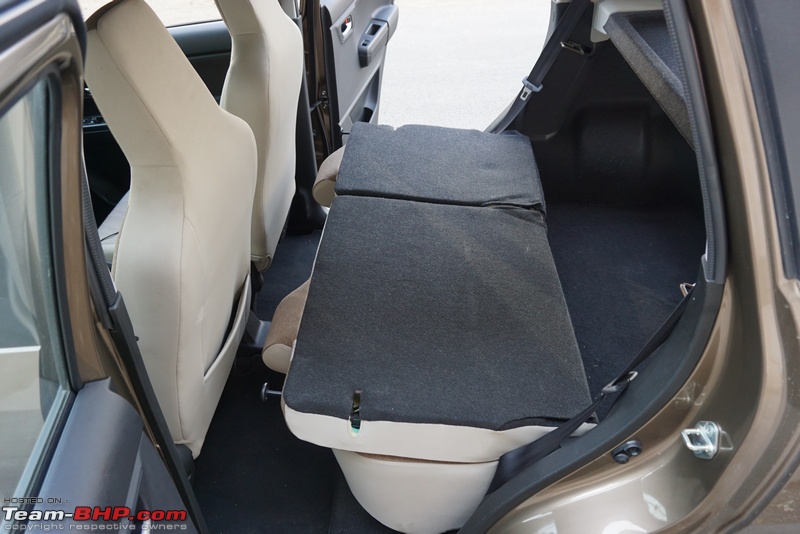 Folding the seat down gives you a cargo capacity of 710 liters. Notice that the boot floor and seatbacks are not level with each other when folded. There is almost a small step between the two:  Loading lip is high and one will have to make an extra effort to load luggage. The boot opening is wide and partial carpeting has been provided even on the sill:  2L bottle placed to give you a rough idea on how high the loading lip is:  Carpet cladding on the hatch to hide the mechanical bits:  No rubber beading provided around the rear windshield - just as you'd expect in a car from this segment:  Only the ZXi variant comes with a defogger. Bits like these stick out like a sore thumb:  Hole to slide in your finger and lift the boot floor up to access the spare wheel:  Spare is a 14" steel wheel shod with a 165/70 section tyre - same as the other 4 wheels:  Tools consist of a jack lever, spanner and a tow hook. As seen earlier, the jack is placed under the driver's seat:  Last edited by Aditya : 28th May 2019 at 15:14. |
| |  (25)
Thanks (25)
Thanks
|
| The following 25 BHPians Thank blackwasp for this useful post: | Aditya, AdityaDeane, AkMar, chiranjitp, digitalnirvana, GTO, InControl, jailbird_fynix, Leoshashi, libranof1987, N33raj, NPV, PGNarain, phoenixash, PowerSpike, RaghuVis, raptor_diwan, Scorpion 10, Simat, sparky@home, swiftnfurious, The_Outsider!, TusharK, vaasu, Varun_HexaGuy |
| | #6 |
| Senior - BHPian | In-Car Entertainment The ZXi variant gets a new 7" capacitive touchscreen head-unit dubbed the 'SmartPlay Studio'. Connectivity is through Bluetooth, USB and AUX. Voice commands, Apple CarPlay, and Android Auto are supported as well. A CD player is missing, though when was the last time you used one? Maruti has provided a couple of apps – Navimaps (by MapmyIndia) and AHA radio. These use your smartphone’s internet for navigation, playing music, displaying weather updates etc. Navigation is through Navimaps, Android Auto and Apple CarPlay. No variants get a reversing camera and it is not possible to retrofit one either. Screen resolution and clarity are impressive for a car in this segment (same system is used in the Baleno facelift). Dedicated keys are provided for those who prefer to use them. Touchscreen is placed on the top of the center fascia, which means that the driver doesn't need to take his eyes off the road. Under harsh sunlight, visibility is average:  Music is played through just 2 speakers - one each on the front doors:  Rear doors have grilles, but don't get any speakers behind them. That’s just terrible cost cutting:  Start the system and you are greeted with an 'S' logo:  Split screen displays both the clock as well as the media being played. Media, phone and connectivity shortcuts are provided as well. It is easy to understand and simple to operate:  In standby mode, the system displays a clock and the day and date:  Media can be played through a variety of sources:  Sound quality is budget grade. Since only 2 speakers are given, the front occupants will hear music at a higher volume than the rear passengers. One good thing, however, is that the sound doesn't distort at higher volumes:  You get the usual sound adjustments:  Set up the equaliser manually...  ...or choose from a range of presets:  Individual volume levels of music, phone ring and call can be set:  Speed dependent volume gets 3 levels or can be kept off:  A variety of system settings can be configured as per the user's choice:   Screen brightness as well as day/night or auto mode can be selected here: 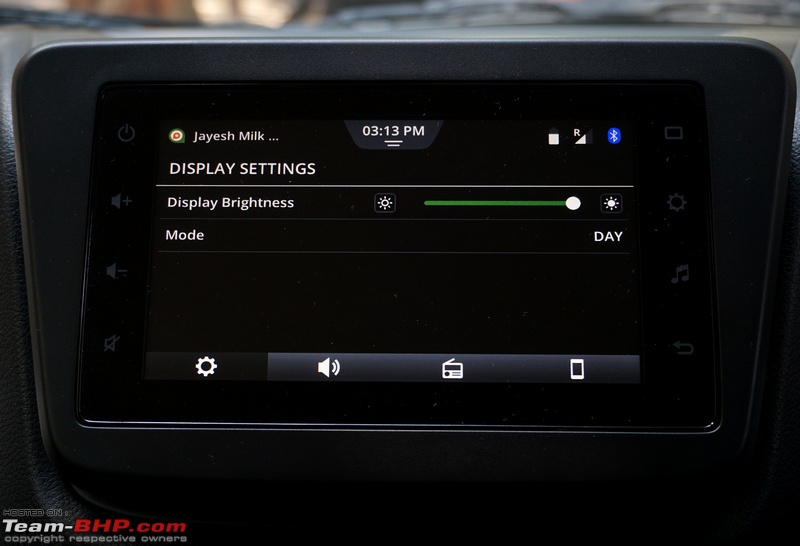 Date and time settings include daylight saving, 24-hour format and display clock settings among others: 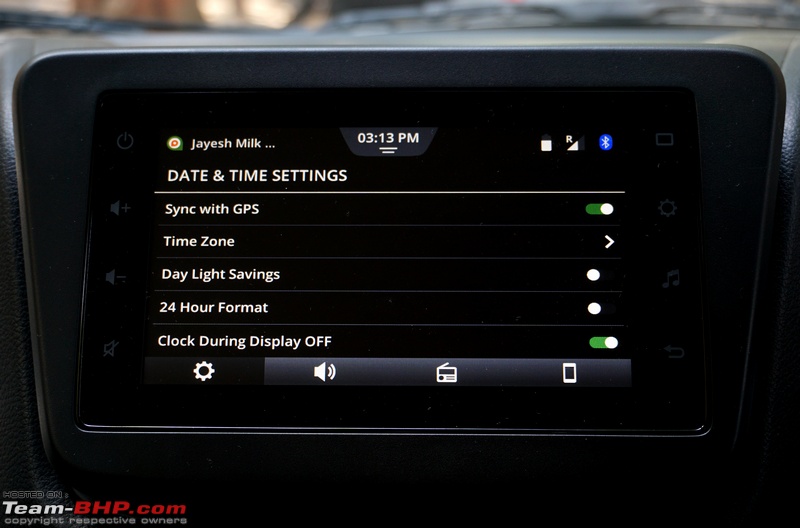 You can also configure the alerts that can be shown on the touchscreen. These include alerts for open door, parking brake, seatbelt and low fuel:  Fuel economy with current range as well as instantaneous mileage can be seen on this screen:  Bluetooth pairing is very easy - the first option asks if you want to connect to a new device or an existing one:  It also asks what all should be enabled for the new device - phone, media and smartphone app connectivity:  Once paired, the top right of the home screen gets signal strength, phone battery indicator and connectivity type (Bluetooth or USB):  This warning comes up when you pair a phone with the compatible mobile app:  The system prompts you for setting up the Navimaps (it runs off your phone, while displaying on the infotainment screen). However, I could not get it to work with my phone:  Dial pad is on the smaller side but usable nonetheless. Note that for safe practices, you should stop the car before dialling a number: 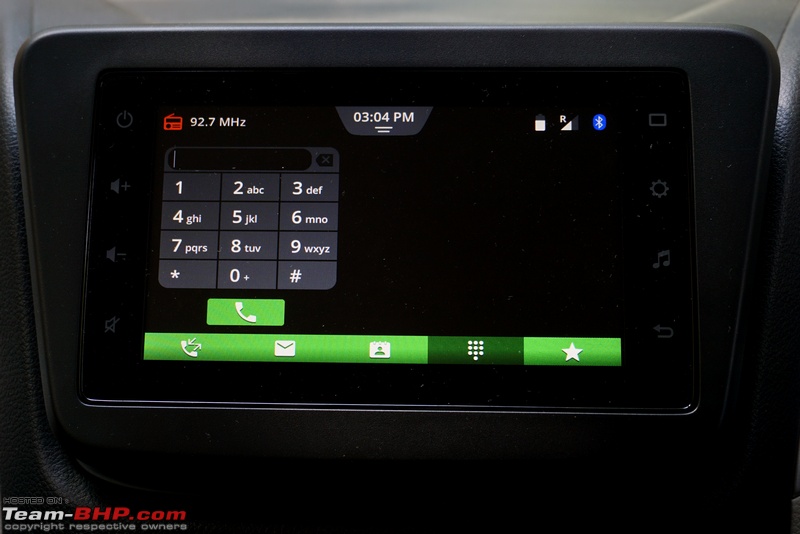 Favourites (if any) will show up on this screen. The bottom buttons are call log, SMS, phone book, dialler and favourites:  Call log displays the recent calls along with the time of call. Tap on them to start a new call:  Incoming call will be displayed like this accompanied by your phone's ringtone. The font size is legible:  When connected with a smartphone, the system can read out the incoming SMS as well as auto reply when you get one...  ...or reply automatically:  One of the preloaded apps is the AHA Internet radio. Music, news and sports channels are offered. It uses your smartphone’s Internet for music etc.:  Music includes Gaana, personal radio, podcasts and internet radio stations:  Local FM stations that are also streamed over the internet are available here. Sound quality is much better than conventional FM:  News podcasts from popular sources like the BBC are included: 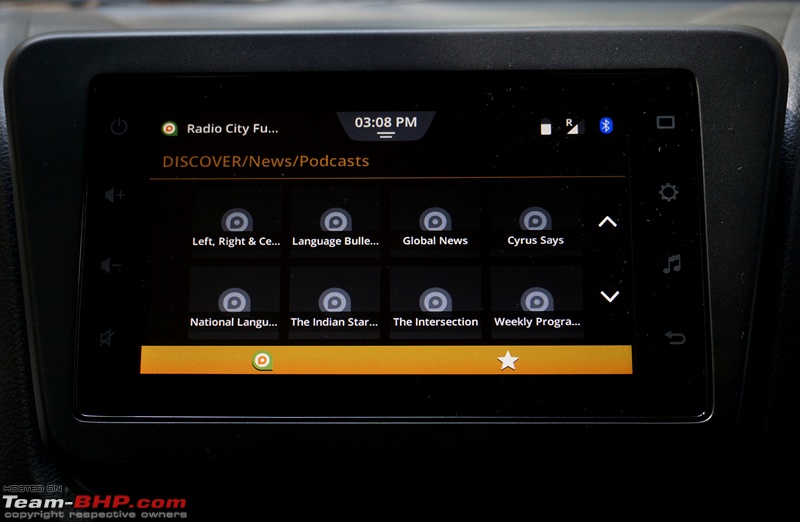 Sport streams include games like cricket, football, etc.:  Want to listen to the news on the go? No problem as long as you have a data connection on your phone:  Football fans can catch up on the UEFA podcast:  SmartPlay Studio categories when connected with a compatible phone: 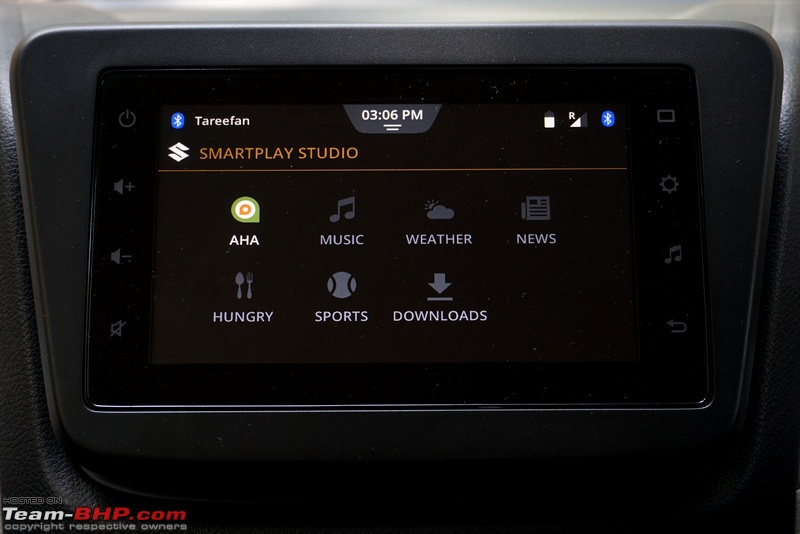 Weather conditions (powered by Custom Weather) can be seen:  Nearby restaurants along with their rating and distance are announced when you go into the "Hungry" category. It is powered by Zomato:  When a particular restaurant is announced, you can even call / navigate to it:  In case of multiple options of connectivity, you can choose the default option:  The WagonR gets Android Auto & Apple CarPlay. To use them, connect your smartphone to the system via a USB cable:  Font size is large and clearly visible:  Dial pad is one size bigger than the default system one:  Songs can be played by the default Music app. If you are subscribed to Apple Music, it can be reached out from here as well:  Google Maps is now available on CarPlay:  Using it is very easy and just like the app on the phone:  Android Auto needs to be initialised in case you are using it for the first time:  You can get directions, make calls, send / receive messages and listen to music through this Android interface: 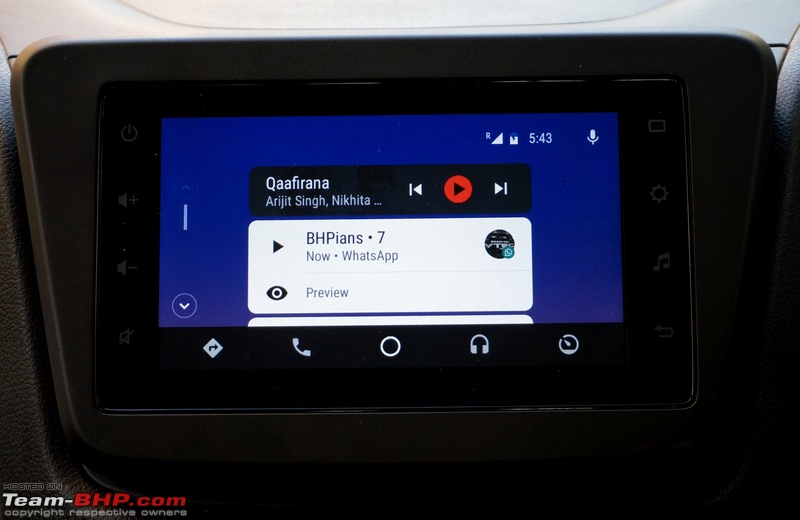 Dial pad is large and easy to use:  Default music app can be changed according to the user's choice. We were using the Gaana app: 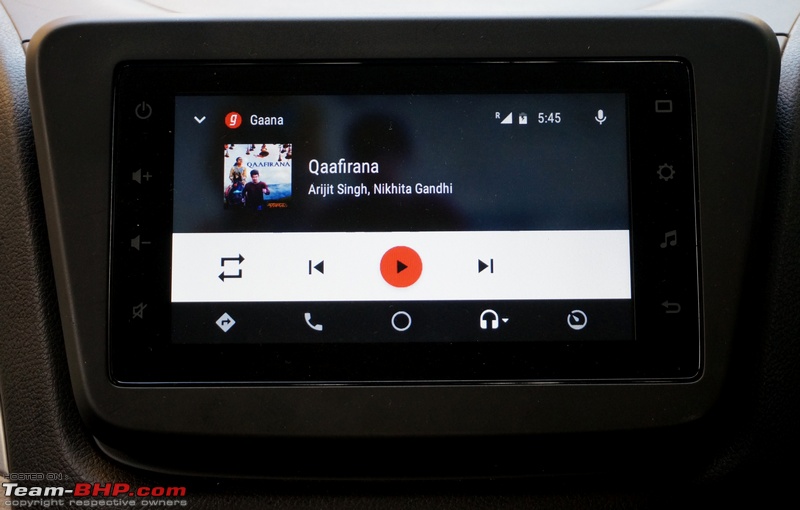 Implementation of the Google Maps, as expected, is much better on Android Auto :  The SmartPlay Studio app is available on both Android and iOS platforms. To prevent unauthorised access, one has to enter the VIN / registration number of the car. Only one instance of this app can be running (among all paired phones):  You will be prompted to download the Navimaps, AHA radio and Suzuki remote control apps:  If you are using Navimaps for the first time, you will need to download the map data, which is provided by MapmyIndia:  There is no physical remote provided, but chauffeur-driven folk can download the Suzuki remote control app on their smartphones & use it to control the system:  You can switch the audio system on/off with the app, adjust the volume to your liking and mute/unmute the system:  You can also select the music source:  While the radio frequency is not displayed, the app works as intended:  Touchscreen doubles up as a display for the reverse parking sensors. Is that a Swift being shown in the display?  . Apart from warning lines, you get audio alerts. However, you can’t add a reversing camera to this display: . Apart from warning lines, you get audio alerts. However, you can’t add a reversing camera to this display: Last edited by Aditya : 28th May 2019 at 15:15. |
| |  (28)
Thanks (28)
Thanks
|
| The following 28 BHPians Thank blackwasp for this useful post: | Aditya, AdityaDeane, AheadAJ, AkMar, AYP, blackfog, dailydriver, digitalnirvana, GTO, InControl, libranof1987, N33raj, NPV, Omkar, PapaKiloSierra9, PGNarain, phoenixash, Ponbaarathi, PowerSpike, PraNeel, raptor_diwan, Simat, sparky@home, swiftnfurious, The_Outsider!, TusharK, vaasu, Varun_HexaGuy |
| | #7 |
| Senior - BHPian | Driving the 1.2L Petrol MT Familiar 1.2L K12 engine found in many other Maruti cars. Notice that it doesn't get an engine cover; looks ugly without it. Airbox sits just behind the engine:  The WagonR is powered by the same 1,197cc, 4-cylinder K12 petrol engine with variable valve timing technology (VVT) as the Swift, Ignis, Baleno and Dzire. The car is also available with the K10 1.0L, 3-cylinder engine from the Alto K10. While the 1.0L is priced ~ Rs. 20,000 lower, the 1.2L is TOTALLY WORTH IT because you get more power, torque and refinement (thanks to the extra cylinder). However, do note that the 1.2L will gulp a little more fuel than the 3-cylinder 1.0L. Still, the price difference is just too small. Heck, some aftermarket remaps cost more money! Go for the 1.2L, it’ll be the best 20K you ever spent in your life. In the WagonR, the 1.2L engine produces 82 BHP @ 6,000 rpm and 113 Nm of torque @ 4,200 rpm, which is identical to its larger siblings. With a kerb weight of merely 830 kilos, the car has a power-to-weight ratio of 99 BHP / ton and torque to weight ratio of 136 Nm / ton. Both these figures overshadow all the B1 segment cars like the Santro, Tiago and Celerio. Due to the lighter kerb weight the power to weight and torque to weight ratios of the WagonR are higher than even its siblings from the B2 segment like the Swift and Baleno. To start the engine, simply twist the key. The clutch is not required to be pressed. Once the engine is fired up, there are no vibrations felt on either the steering, pedals or the gear lever. In general, the refinement of the engine at idle is very good. However, a slight shake can be felt on the seat occasionally. As we have seen earlier, the 1.2L K-series is a gem of a motor. Barring the Ignis, the WagonR is the lightest car in the Maruti stable to use it. Therefore, the engine feels more sprightly than it does in most other Marutis. This engine has completely changed the character of the WagonR. You can actually have a little bit of fun with it. Throttle response is very crisp. The WagonR moves off from a standstill easily. Driveability in the city is good and it doesn’t need excessive downshifts. Thanks to its light kerb weight, the car picks up speed nicely. The engine's low rpm behaviour will satisfy most drivers and you can potter around town in the 5th gear at 50 km/h with the engine ticking over lazily at 1,500 rpm. There is adequate power on offer and even when you need to close a gap quickly, you won’t feel the need to downshift. Keeping up with city traffic is no trouble for the 1.2L petrol. This low-speed behaviour coupled with small size, light controls, good frontal visibility and sorted ergonomics make the WagonR a very good car for driving in the city. Take the WagonR out on the open roads and one can really enjoy the performance that the 1.2L unit offers. Power delivery is linear in nature and the rev-happy engine is refined throughout the rpm range. The engine feels very responsive above 2,500 rpm and accelerates strongly all the way to the redline. 1st gear maxes out at 48 km/h with second good till 88 km/h till the rev limiter kicks in. Along with the spirited performance, the 1.2L engine sounds sweet, and enthusiasts will enjoy pushing it hard. The strong engine makes the WagonR a good performer on the highway. The only downside is that Maruti has set the max engine rpm to a very conservative 6,300 rpm. You get the feeling that the engine has a few hundred rpms left in reserve when you (unexpectedly) hit the rev limiter in the middle of an overtaking manoeuvre. This will force you to upshift, losing time in the process. The WagonR can cruise on the highway in 5th gear at 100 km/h with the engine turning over at 2,600 rpm. While there is sufficient power throughout the rev range, it’s best to shift down a gear or two while overtaking on single lane highways to keep the engine in the meat of its power band. The clutch is very light and pressing it takes close to no effort. However, we found the travel to be on the longer side and takes a bit of getting used to. The 5-speed manual gearbox is smooth to operate with short throws. It’s precise so you will never miss a gear or slot into the wrong one. The gearshift quality along with the rev-happy nature of the petrol engine makes this combination the perfect choice for enthusiasts. The WagonR petrol has an ARAI rating of 21.5 km/l, which is better than the Santro (20.3 km/l) and Datsun GO (20.63 km/l). However, it is way off the Celerio's 23.1 km/l or the Tiago's class-leading 23.84 km/l. NVH is rather basic. While the WagonR does very well at slow speeds and around town and the engine is barely audible at city rpms. But when you climb up the revs, it is louder than other Marutis with the same engine. Reason = Poorer insulation. At speeds above 100 km/h, road and wind noise are high. These get louder as the speed increases. What’s worse, while driving over broken roads, you’ll hear pebbles hitting the inside of the wheel arch (as there is partial / no cladding). There are some vibrations felt on the steering wheel as well as the gear lever at higher rpms. Free-revving petrol engine produces 82 BHP and 113 Nm of torque:  No insulation under the bonnet...  ...or on the firewall:  No underbody protection - not even a plastic sheet. You can see the ground below clearly:  Fuse box sits to the extreme left of the car in the engine bay:  Underside of the cover contains a diagram of the fuse box:  Black gearknob is nice to hold. While it gets a leather boot, a chrome / silver outline could have been provided to make it look classy: 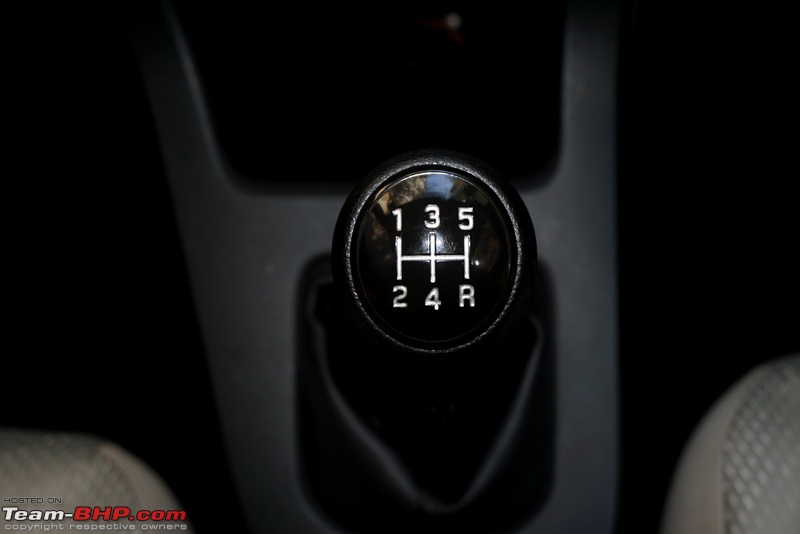 Gearshift indicator in the manual suggests when to shift up or down. Newbies will appreciate this:  Last edited by Aditya : 28th May 2019 at 15:16. |
| |  (27)
Thanks (27)
Thanks
|
| The following 27 BHPians Thank blackwasp for this useful post: | Aditya, AdityaDeane, AheadAJ, AkMar, AYP, dailydriver, digitalnirvana, GTO, InControl, jailbird_fynix, lemedico, Leoshashi, libranof1987, N33raj, NPV, PGNarain, phoenixash, Ponbaarathi, PowerSpike, Simat, sparky@home, swiftnfurious, The_Outsider!, TusharK, vaasu, Varun_HexaGuy, vnabhi |
| | #8 |
| Senior - BHPian | Driving the 1.2L Petrol AMT Apart from the 5-speed manual transmission, the 1.2L petrol engine is available with a 5-speed automated manual transmission. The 5-speed AMT unit is sourced from Magneti Marelli and is being offered in both - the VXi and ZXi variants. While this makes the car easier to drive in traffic, the Santro’s AMT with its electric actuators is indisputably the superior. Like the outgoing car, the AMT is also available with the 1.0L engine. The AMT mechanism is a simple bolt-on job and it uses the WagonR MT's existing gearbox. It’s pretty straightforward in the way it works. Mechanically, the AMT gearbox is identical to the WagonR’s manual transmission. What's different is how the clutch is operated and how the gears are shifted. In the manual, the driver is responsible for these tasks. With the AMT, hydraulic actuators located in the engine bay operate the clutch and shift gears. There's no clutch pedal, and zero driver input is required for gearshifts, making it exactly like a conventional automatic to drive. Simply put, the mechanical functions of operating the clutch and gear lever have moved from inside the cabin to the engine bay. To know more about AMTs & how they work, click here. AMTs, as we know, are cheaper to build than proper automatic gearboxes (torque converters, dual clutches). This has allowed Maruti to price the WagonR AMT lower than it would have to if it used a regular automatic. Maruti certainly knows the market well. However, at Rs. 5.37 lakhs (ex-showroom, Delhi) for the VXi, WagonR is Rs. 18,000 more expensive than the Santro Magna AMT and Rs. 9,000 more expensive than the Tata Tiago XTA. That said, we must remember that the WagonR has a 1.2L, 4-cylinder engine unlike the Santro, which comes with a 1.1L unit and the Tiago, which comes with a 3-cylinder motor. Compared to the MT, the AMT carries a premium of ~ Rs. 47,000 across all trim levels. The AMT has the standard N, R, D and M positions. There is no 'P' (park) mode or gear unlock button like in a conventional AT. To start the car, the gear shifter has to be in N (neutral) position and the driver's foot has to be on the brake pedal. It is only when these conditions are met that the engine will crank. The WagonR AMT has no problem rolling off from standstill. Throttle response when starting off is very good. The car feels very peppy due to the light kerb weight and the awesome engine. The AMT functions like a regular automatic gearbox and, as the driver doesn't need to press a clutch pedal or shift gears, it results in a stress-free drive. Additionally, putting the car in D / M mode and releasing the brake pedal will result in the WagonR creeping forward without any accelerator input. In bumper to bumper traffic, you can drive the WagonR with only one pedal (i.e. the brake). Without any throttle input, the car will keep moving at ~7 km/h. In general, keeping up with urban traffic is easy. However, the gearbox suffers from slow gearshifts (particularly during upshifting) and there is a delay of a second or so from the time one gear is disengaged and the next one is engaged. This results in a jerk and as we've noticed in other AMTs - the lull in acceleration makes your head bob forward. If the car is being driven in a relaxed manner, things are smoother (although you will still notice each gearshift). The gearbox's operation is silent too. It's only when the driver gets aggressive with the throttle that things get jerkier, resulting in your head swaying back & forth. This can be a deal breaker for some (including GTO). That said, Maruti is definitely improving the smoothness of the AMT with each new car launch; however, there is no comparison with a conventional AT in terms of refinement. Again, it must be remembered that the Santro’s AMT with its electric actuators is indisputably superior to the WagonR's. It is important to note that, while every upshift from 1st to 3rd gears is felt, the shifting between 4th and 5th gears is smoother. There is a way of reducing these jerks. When accelerating up to speed, let off the accelerator at intervals. The AMT will seize that opportunity to upshift. Overall the larger K12 engine is a better combination with the AMT vs the AMT + K10 in the Celerio and Alto. The larger motor masks the shortfalls of the AMT significantly. The AMT and K10 engine combination is jerkier and because the smaller engine is down on power and torque the gearbox has more work to do. On the open road, the AMT is much more at ease with a relaxed driving style than an aggressive one. It works well for a driver who prefers to build up speed gradually. The engine has enough grunt to keep the WagonR running at triple digit speeds all day long and with a light foot, the transmission is also smoother. Driving in D mode is good on the highway as long as you are happy to cruise. Speaking of which, she cruises at 100 km/h in 5th gear at 2,800 rpm. Put your foot hard down and the engine revs to 6,000 rpm before the transmission shifts up. What is noticeable is the way the revs jump up when the driver slams the throttle to match the revs in the lower gear while the transmission eagerly shifts down. The shift, however, is nowhere close to being as quick as a DSG. That said, the response time is not as slow as some other cars with AMT. It is quite acceptable for expressway driving. Even then, it's best to use the manual mode while overtaking slower cars on undivided highways. The AMT comes equipped with 'Manual mode' that can be engaged by moving the gear shifter to D, and then to the left. Pull the shifter down to upshift and push it up to downshift. In M mode, the transmission does not upshift on its own. Driven hard, the engine will rev to 6,300 rpm. It will not allow you to upshift either if it finds the revs too low. It will also not downshift unless the revs fall drastically. M mode comes in handy when one wants to overtake quickly. While the response time is far from instant, it's still a bit faster than D mode. M mode is useful to bring the engine into its power band before an overtaking manoeuvre & also during the actual overtaking (to prevent the AMT from an unintentional + slow upshift while you're overtaking). Another time when the M mode can be used is when you desire engine braking. Driving downhill, this mode aids engine braking which in turn, reduces the workload on the brakes. It must be mentioned that there is a slight delay between the time you tap the gear lever and the gearshift actually happening, resulting in a jerk. Therefore, even in this mode, it is advisable to let go off the throttle for an instant while upshifting, just like you would do in the case of a conventional manual transmission. NVH levels are identical to those of the MT. A slight buzz can be felt on the gear shifter at high rpms. The only visible hardware change in the AMT is this extra oil container above the gearbox. The Magneti Marelli sourced hardware sits on top of the 5-speed gearbox:  Even the small engine bay is not completely filled up by the 1.2L motor: 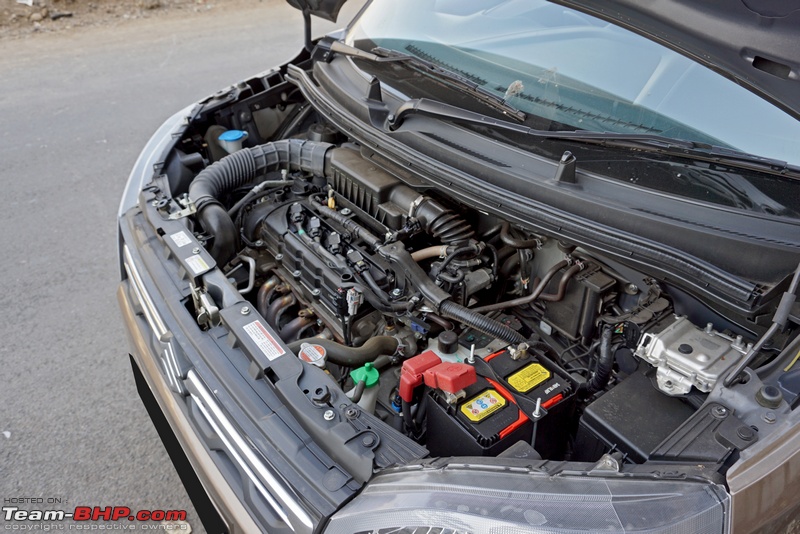 AMT shifter is lifted straight from the Celerio and Ignis. Shift actions are average and feel like any other AMT though the larger 1.2L engine masks the AMT’s inherent flaws to an extent:  Shift to the left for 'manual mode'. Move it down for upshifts & vice versa. All R, N, D & M are backlit in orange:  No clutch pedal means more space in the footwell. The dead pedal is carried over from the manual. A comfortable dead pedal is most important in an AT to rest the idle left foot. As mentioned earlier, while this dead pedal could have been wider, it is still useable:  Foot on the brake symbol lights up to remind you to press the B-pedal when changing from D to R or cranking the engine in N:  AMT's MID gets a gear indicator. The "D" next to the "1" denotes "automatic" mode, while the "M" with the "1" is the "manual" mode. Currently selected gear is shown in both, automatic & manual modes. The transmission allows you to shift up to 2nd gear even when the car is standing still:  Last edited by Aditya : 28th May 2019 at 15:16. |
| |  (21)
Thanks (21)
Thanks
|
| The following 21 BHPians Thank blackwasp for this useful post: | Aditya, AdityaDeane, AYP, dailydriver, digitalnirvana, GTO, haisaikat, InControl, jailbird_fynix, Leoshashi, libranof1987, N33raj, NPV, PGNarain, Sanidhya mukund, Simat, Simhi, sparky@home, The_Outsider!, vaasu, Varun_HexaGuy |
| | #9 |
| Senior - BHPian | Ride & Handling The WagonR comes with a McPherson strut suspension setup at the front and a torsion beam setup at the rear. The overall ride quality is better than outgoing car. It has improved and is compliant for the most part. No owner will complain. Small bumps on the road are absorbed quite well. Even at the rear, bumps are not jarring for the occupants. However, we cannot call the ride plush. Large and sharp bumps make themselves felt. On the open road, most bumps and undulations will not bother the occupants of the car. However, if you go too fast over larger bumps, the ride gets very bouncy and uncomfortable. We would definitely recommend slowing down for large bumps and potholes. The suspension is not silent in operation either. You can hear it going about its work, especially on bad roads. The high-speed stability of the WagonR is just about okay. Just don’t push too hard. The car is at home most in the city, not on the highway. The rear end can get bouncy on road undulations. Crosswinds affect it on the expressway as well. If you take it on the highway, drive it in a sedate manner. You can feel the lightweight nature of the car at speed. What’s worrying is that while the engine will easily take the car to high speeds, it isn’t capable of handling that. So, you should be careful and avoid it. In terms of handling, grip levels are fair and the car can change direction easily. However, you must remember that it is a tall car. Body roll is present and noticeably more than the Santro. While the 165/70 R14 MRF ZVTV tyres provide acceptable grip at city speeds, they are still too narrow and designed more towards mileage than grip. Changing to wider and stickier rubber should make a big difference to the WagonR’s dynamics. While the car holds its line fairly well while taking corners at medium speeds, wider rubber would have definitely made a difference. The WagonR comes with electric power steering, which is one-finger light during parking and city speeds. This makes it a very easy car to drive in urban situations, but it can also be unnerving as some might feel the steering is too light and vague and you get no feedback at all. It’s pretty much dead like a video game steering. The mass market will like it though. At higher speeds the steering does weigh up, but the complete lack of feel or feedback can be unnerving. It is poorly calibrated and requires frequent corrections to keep the car going in a straight line. We needed to do this even at 80 km/h. The WagonR has a tight turning radius of just 4.7m, is wider than the outgoing car's 4.6m. Still, it is smaller than the Santro's 4.78m and makes U-turns a breeze to execute. However, the steering does not return to center and that means the driver will have to actually turn the wheel back straight. Ground clearance is rated at 165 mm. That's at par with most of the other cars in the segment, but not quite as good as the Tata Tiago (170 mm). During the period of time we had the WagonR, we encountered no problems over large speed breakers or even when we took it off the road for photography. The WagonR comes with disc brakes at the front and drum brakes at the rear. On hard braking, the car stops in a straight line, without any drama. While the brakes get the job done, they are not exceptional. The brake pedal has a short travel and the brakes bite early on, but I did find it to be spongy and wish that it provided more initial bite. I have mentioned earlier that the WagonR could do with wider tyres. A tyre upgrade is almost certain to improve the stopping power of the car. ABS is standard on all variants of the WagonR. It is not intrusive and kicks in only on hard braking in emergency situations. Last edited by Aditya : 28th May 2019 at 15:17. |
| |  (21)
Thanks (21)
Thanks
|
| The following 21 BHPians Thank blackwasp for this useful post: | Aditya, AkMar, dailydriver, digitalnirvana, gauravanekar, GTO, InControl, jailbird_fynix, Leoshashi, libranof1987, Maverick Avi, N33raj, NPV, Ponbaarathi, RaghuVis, RGK, Simat, Simhi, sparky@home, UMXR, Varun_HexaGuy |
| | #10 |
| Senior - BHPian | Other Points • You can expect a lot of 2nd-gen WagonR owners to buy the new WagonR because it’s fixed a lot of the old car’s shortcomings. Not convinced? Click here to read this post. Of course, here is the opposite reaction from another WagonR owner. • Wheelbase is same as the Ignis - the new WagonR is a baby Ignis. • If you’re considering the top-end WagonR, better go for the Ignis which is a higher quality product overall. Price difference is nothing in EMI terms, especially if you consider the discounts on offer. • Apart from the Nutmeg Brown shade of our review car, the WagonR is offered in 5 body colours - Superior White, Silky Silver, Magma Grey, Autumn Orange and Poolside Blue. • Check out the lower variant’s ugly head-unit here. • Fuel tank capacity = 32 liters, which is 3 liters lesser than the outgoing car. The 1.2L engine has an ARAI-certified FE of 21.5 km/l, while the 1.0L is rated at 22.5 km/l for both MT and AMT variants. • Doors auto-lock at 20 km/h. They don't unlock when you switch off the engine, but only when you remove the key from the ignition. • Standard warranty of 2 years / 40,000 km. Extended warranty for up to 5 years / 1,00,000 km can be purchased (we always recommend it). • First service at 1,000 km / 1 month, second at 5,000 km / 6 months, third at 10,000 km / 1 year (inspection) and thereon every 10,000 km / 1 year. First 3 services are labour-free. • The single OEM horn is too weak. Wish Maruti had given it a proper dual-tone horn. How much more would it cost anyway? • ZXi variant gets dual airbags and front seatbelts with pre-tensioners and force limiters as standard. For an additional Rs. 5,000-7,000, you can get the 2nd airbag in other variants. That's dirt cheap. • Maruti says that they will not sell the new WagonR in the taxi market, but the old WagonR is no longer in production and given its success in the Uber & Ola space, we expect sales to start eventually. • CNG option available with the 1.0L LXi and LXi(O) variants priced at Rs. 4.85 lakh and Rs. 4.89 lakh (ex-showroom, Delhi) respectively. 60L CNG tank installed in the boot. ARAI FE rating = 33.54 km/kg. • Factory fitted fire extinguisher is offered on the CNG variants. • Earlier top-end variant (Stingray) got alloy wheels, projector headlamps & leather-wrapped steering wheel. Why are they not available in the new model? • Lots of extras & customisations available. Check them out here. • The Maruti WagonR e-brochure can be viewed here - WagonR.pdf. • The Maruti WagonR Accessories brochure can be viewed here - Accessories.pdf • Disclaimer : Maruti invited Team-BHP for the WagonR test-drive. They covered all the travel expenses for this driving event. Last edited by Aditya : 28th May 2019 at 20:36. |
| |  (20)
Thanks (20)
Thanks
|
| The following 20 BHPians Thank blackwasp for this useful post: | Aditya, AdityaDeane, AkMar, AYP, dailydriver, digitalnirvana, GTO, InControl, jailbird_fynix, lemedico, Leoshashi, N33raj, NPV, PraNeel, PrasunBannerjee, Punatic, RGK, Simat, sparky@home, Varun_HexaGuy |
| | #11 |
| Senior - BHPian | Smaller yet Significant Things No label on the flap or fuel cap indicating the engine's diet. The fuel cap gets a string that keeps it attached to the flap. The flap also get a slot to park the cap. A spill protector has been provided:  In the case of CNG variant, the filler is located at the top left corner. The CNG plate is now placed behind the flap, rather than above the flap like the outgoing car:  India-friendly ORVMs will move the other way if a biker side-swipes them:  Front wheel wells get partial cladding:  Absolutely no wheel well cladding at the rear. One can clearly hear the stones & pebbles hitting against the bare metal while driving:  32-liter fuel tank is the smallest in the segment. Even the outgoing car came with a 35-liter unit:  Halogen headlamps have a good throw and light up the road sufficiently:  With the high beam engaged, the throw is very impressive especially for a budget car like this:  Illumination of the instrument cluster can be adjusted in 4 steps by using the MID stalk:  Lower variants get a simple instrument cluster without a tachometer and a very basic MID:  Tyre pressure is 36 PSI front and 32 PSI rear under all load conditions and for both wheel-tyre combinations:  Rubber beading is of a good quality. It is soft and well-fitted as well:  Driver's floor mat comes with dual hooks to stop it from sliding around & messing with the pedals. Notice the warning label in multiple languages:  All interior switches (except the power window switches) are backlit in orange:  Plate with the VIN and engine number is stuck on the driver-side B-pillar:  VIN is stamped above the firewall and visible through a cut-out in the plastic cladding:  Apple CarPlay prohibits some actions (like manually dialling a call) when driving:  Simple key with the integrated lock / unlock buttons:  Seatbelt reminder is displayed on the infotainment screen apart from the MID...  ...as is the low fuel alert:  VXi variants come with this 'Smartplay Dock' audio system head-unit. The circular piece at the top is where a mobile holder can be fitted, making your phone's display as the infotainment screen. It has Bluetooth, USB and Aux connectivity. Take a look at this post by BHPian CrAzY dRiVeR to check out the mobile dock in action:  A storage drawer has been provided under the front passenger's seat:  Medium-sized drawer has a load carrying capacity of up to 1 kg. It is useful to keep small items out of sight:  The basket can also be removed completely. The outgoing car had a handle to carry it (reference image):  Constant blast of cold air from the driver-side middle air-con vent freezes the driver's left hand:  These sweet alloy wheels are among the accessories available. Sadly not even the top ZXi trim gets these as standard. The outgoing WagonR came with alloy wheels on the StringRay and the ZXi+ variant later on. Also notice the wheel arch cladding, which retails for Rs. 5,290 for a set of 4:  Along with the wheel arch cladding, the side extender (Rs. 6,490) - the black and silver bit, changes the appeal of the car. Must say I like this look over the stock car:  Last edited by Aditya : 28th May 2019 at 15:18. |
| |  (47)
Thanks (47)
Thanks
|
| The following 47 BHPians Thank blackwasp for this useful post: | Aditya, AdityaDeane, AkMar, aniketi, arjab, AYP, BoneCollector, cn.vishnu, dailydriver, Déesse, desiaztec, digitalnirvana, gauravanekar, Geo_Ipe, GTO, haisaikat, InControl, jailbird_fynix, jnanesh, johannskaria, lemedico, Leoshashi, libranof1987, manij, mh09ad5578, N33raj, nmenon, NPV, Omkar, padmrajravi, PapaBravo, Ponbaarathi, PrasunBannerjee, RGK, sainyamk95, Sanidhya mukund, Scorpion 10, Simat, sparky@home, theexperthand, The_Outsider!, vaasu, Varun_HexaGuy, WindmillsFly, WorkingGuru, yoscenario2000, ysjoy |
| |
| | #12 |
| Team-BHP Support  | Re: Maruti WagonR : Official Review Thread moved from the Assembly Line to the Official Reviews Section. Thanks for sharing! |
| |  (4)
Thanks (4)
Thanks
|
| The following 4 BHPians Thank Aditya for this useful post: | blackwasp, digitalnirvana, GTO, Leoshashi |
| | #13 |
| Senior - BHPian Join Date: Apr 2007 Location: Mumbai
Posts: 1,186
Thanked: 2,607 Times
| Re: Maruti WagonR : Official Review Thanks blackwasp for this review. I was waiting for this one since quite a while. Though not a high profile car, it is an important one in the Indian market, so was eager to know Team BHP'S take on it. And who better than blackwasp to review it! Your experience with your Uber WagonR clearly shows in this review. It is clear that there have been lots of improvements in this car over the previous generation. That is a really good sign. However there are some things which could be deal breakers 1. VXi without tacho. Maruti is slowly degrading VXi variant across cars. There was a time when VXi variant meant fog lamps standard. Now VXi does not get fog lamps in any car while WagonR VXi loses tachometer as well 2. Spartan interiors. 3. 2 speakers only! And that horrible looking head unit of lower variants. What was maruti thinking while designing it! 4. NVH on higher side Ignis makes a strong case for itself. Consider this, the WagonR 1.2 VXi Mt and Ignis Delta MT are priced only 49K apart from each other! The premium for ignis is worth it in my opinion Nevertheless, the WagonR will still be a hit  Last edited by AkMar : 28th May 2019 at 16:26. |
| |  (5)
Thanks (5)
Thanks
|
| The following 5 BHPians Thank AkMar for this useful post: | blackwasp, dailydriver, GTO, mh09ad5578, Simat |
| | #14 | |
| BHPian Join Date: Mar 2017 Location: Kolkata
Posts: 556
Thanked: 2,032 Times
| Re: Maruti WagonR : Official Review Quote:
Kindly refer to the attached image from owners manual. Thanks. | |
| |  (7)
Thanks (7)
Thanks
|
| The following 7 BHPians Thank NaXal for this useful post: | blackwasp, cn.vishnu, dailydriver, ganeshb, GTO, libranof1987, Simat |
| | #15 |
| Team-BHP Support  | Re: Maruti WagonR : Official Review Thanks Kanad. Glad I could assist you with this review, and being an ex-WagonR owner (like yourself) - I was really keen to see if the WagonR had retained its traditional strengths during this transformation. Trust Hyundai to bring out the best in MSIL and that surely has been the case with the WagonR. I doubt Maruti would have improved it so much had it not been for the rumours of a new Santro. Maruti has worked on improving the known strengths of the car while working on some of the weaknesses so as they are not obvious deal breakers anymore. In essence, they've stuck to the quintessential WagonR formula - and while it may not appeal to enthusiasts as always, certainly not a bad strategy when almost 1/3rd of the customers are repeat buyers of the brand. And going by the sales numbers, this strategy seems to have worked for them. Last edited by CrAzY dRiVeR : 28th May 2019 at 17:21. |
| |  (8)
Thanks (8)
Thanks
|
| The following 8 BHPians Thank CrAzY dRiVeR for this useful post: | AkMar, blackwasp, GrammarNazi, GTO, InControl, jnanesh, Leoshashi, theexperthand |
 |


